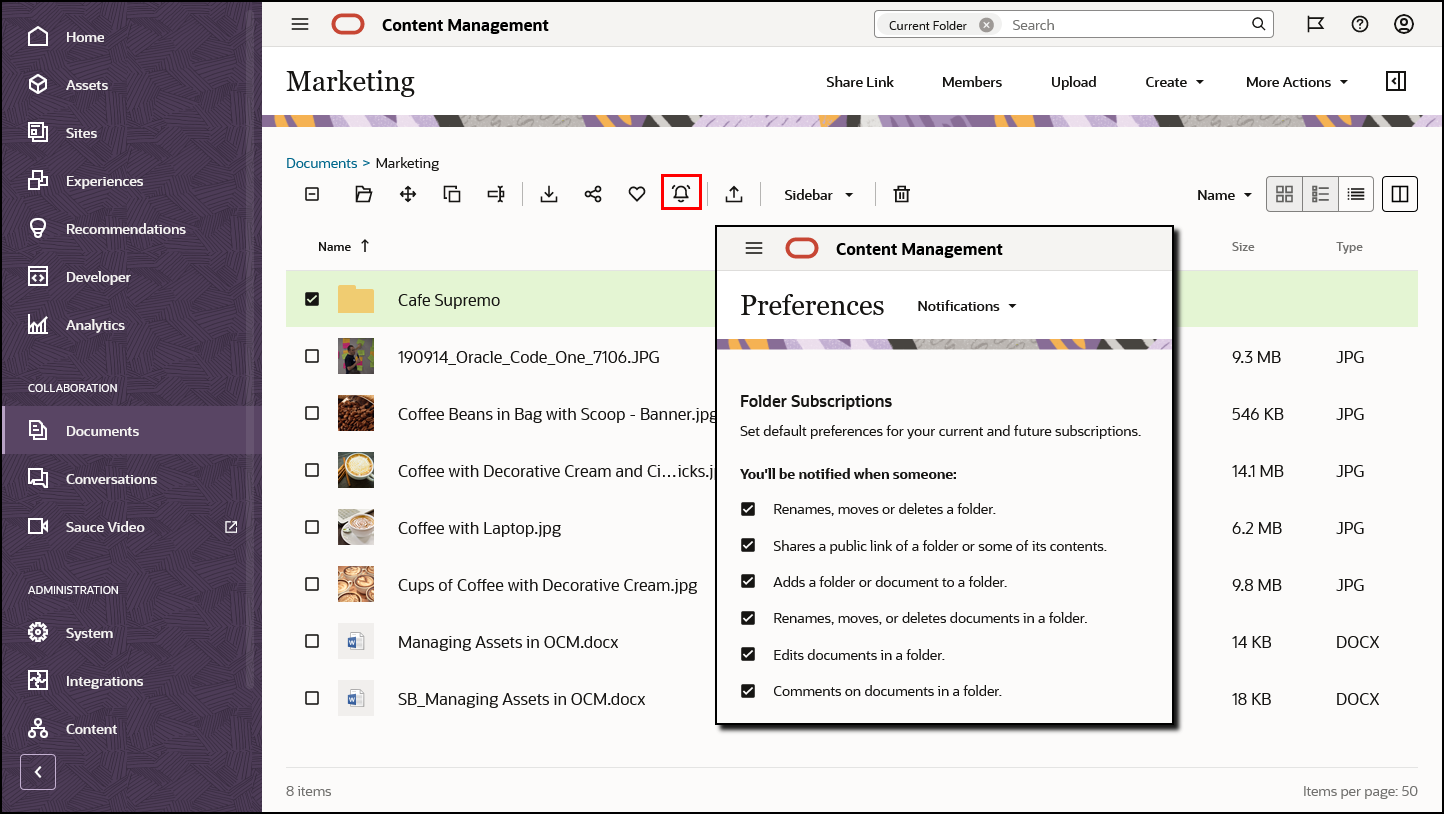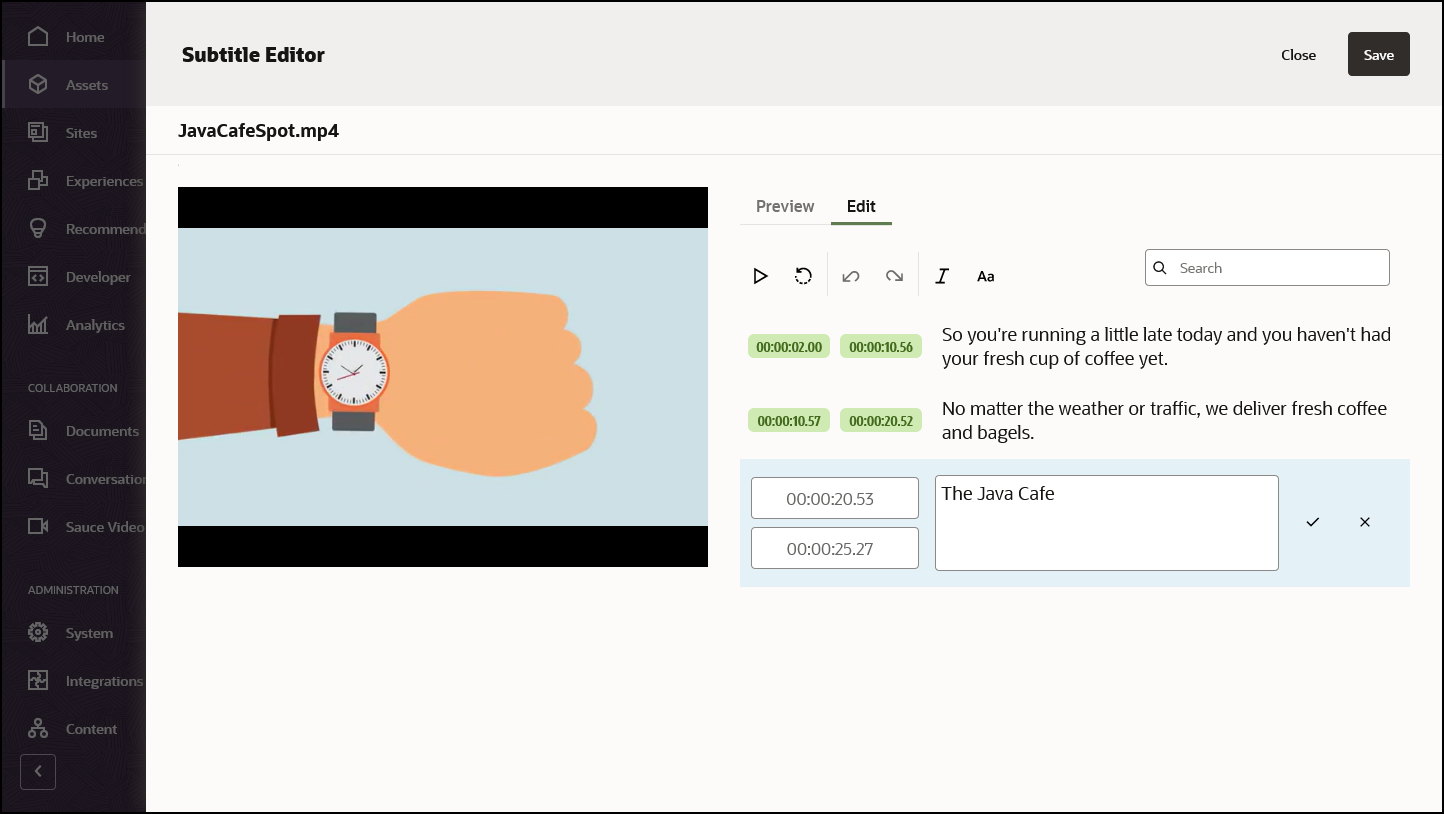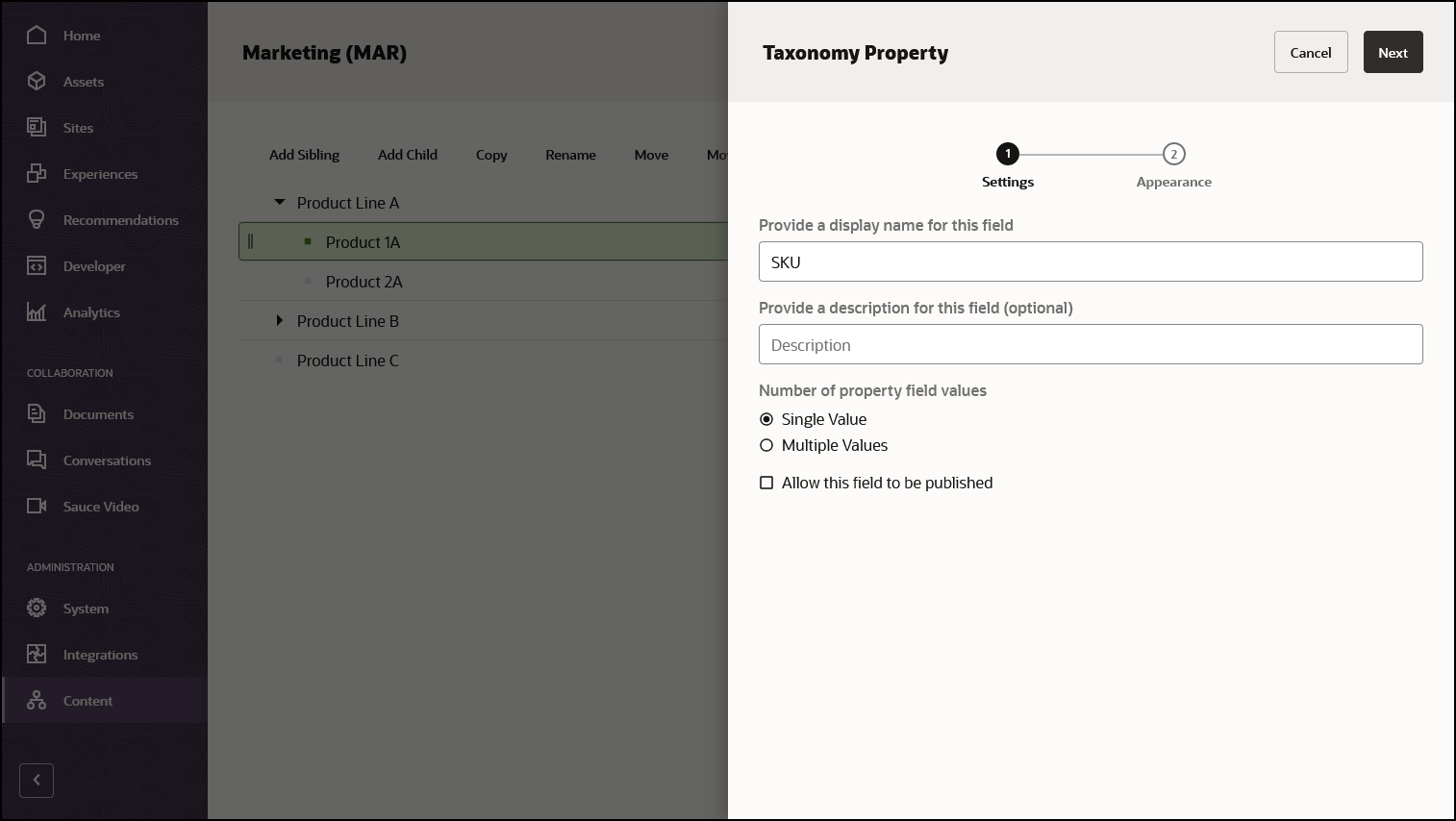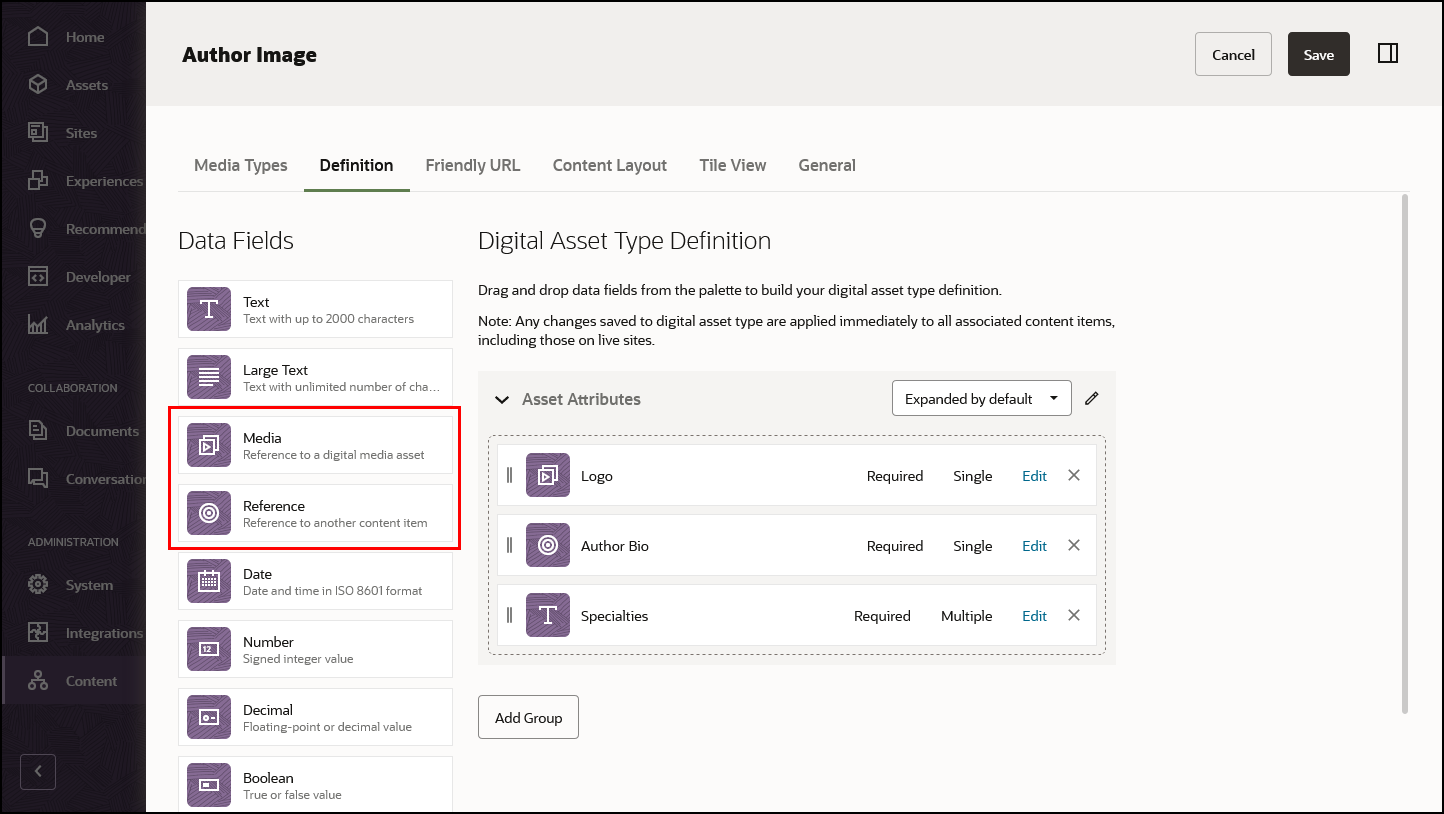What’s New for Oracle Content Management
23.12.1 — January 2024
- The Oracle Content Toolkit includes the following updates. More...
- New valid value for
<type>for thecec list-activitiescommand:- asset
- New valid asset activity categories for the
cec list-activitiescommand:- lifecycle
- publishing
- New valid value for
23.11.1 — November 2023
New Repository Export/Import
Oracle Content Management now allows you to export and import repository content. The Export Jobs and Import Jobs pages allow you to track the export and import jobs. More...
- The Oracle Content Toolkit includes the following updates. More...
- New
cec replicate-sitecommand, which replicates a site. - New
cec export-repositorycommand, which exports a repository. - New
cec import-repositorycommand, which imports a repository. - New
cec replicate-repositorycommand, which replicates a repository. - New
cec describe-localization-policycommand, which lists the properties of a localization policy on OCM server. - New
cec describe-translation-jobcommand, which lists the properties of a translation job on OCM server. - New
cec describe-collectioncommand, which lists the properties of a collection on OCM server. - New valid value for
<action>for thecec control-sitecommand:- set-custom-property
- remove-custom-property
- For the
cec control-sitecommand, option--name(-n)can also indicate custom site property name and option--value(-v)can also indicate custom site property value. - New supported property for the
cec list-assetscommand:- repository
- New options for the
cec list-translation-jobscommand:--type(-t)--status(-a)--repository(-r)--namefilter(-n)--orderby(-o)
- New valid values for
<type>for thecec list-translation-jobscommand:- assets
- sites
- New valid values for
<status>for thecec list-translation-jobscommand:- READY
- INPROGRESS
- TRANSLATED
- FAILED
- New valid values for
<orderby>for thecec list-translation-jobscommand:- name
- connectorName
- updatedDate
- New
23.10.1 — October 2023
- There is a new Toolkit PowerShell feature that allows power users to run CLI-like commands for listing or querying information about Oracle Content Management (OCM) objects in the web interface. The commands available in the web interface are a subset of the CLI utilities that are available in the OCM Content Toolkit. More...
- The Oracle Content Toolkit includes the following updates. More...
- New
cec list-groupscommand, which lists groups on OCM server. - New
cec list-userscommand, which lists users on OCM server. - Option
-vfor thecec list-assetscommand allows to validate the existence of the following resources:- nativefile
- reference
- textlength
- New
--length(-g)option for thecec list-assetscommand, which indicates the maximum text length that asset fields cannot exceed. - New valid value for
<type>for thecec list-activitiescommand:- taxonomy
- Option
-bfor the commandscec execute-post,cec execute-put, andcec execute-patchcan also indicate stringified JSON for the request payload. - New
--skipdependencies (-x)option for thecec create-translation-jobcommand, which is used to not translate asset dependencies.
- New
23.9.2 — September 2023
- The smart classification feature (part of smart content) has been deprecated and removed from the product in this release of Oracle Content Management.
- You can now customize the message users see if they attempt to invite unregistered users when external users are disabled. More...
- The Content Item component now includes a Publish Later option when creating or editing a content item. More...
- When you install the desktop app, you can now select whether to install only for the current user or for all users on the machine. More...
- The Preferences user interface has been updated and new features have been added. More...
- The preferences have been reorganized into tabs that group related settings.
- There are new sync preferences for what sync should do when you delete a folder on your device and when you move a folder out of your local account folder on your device.
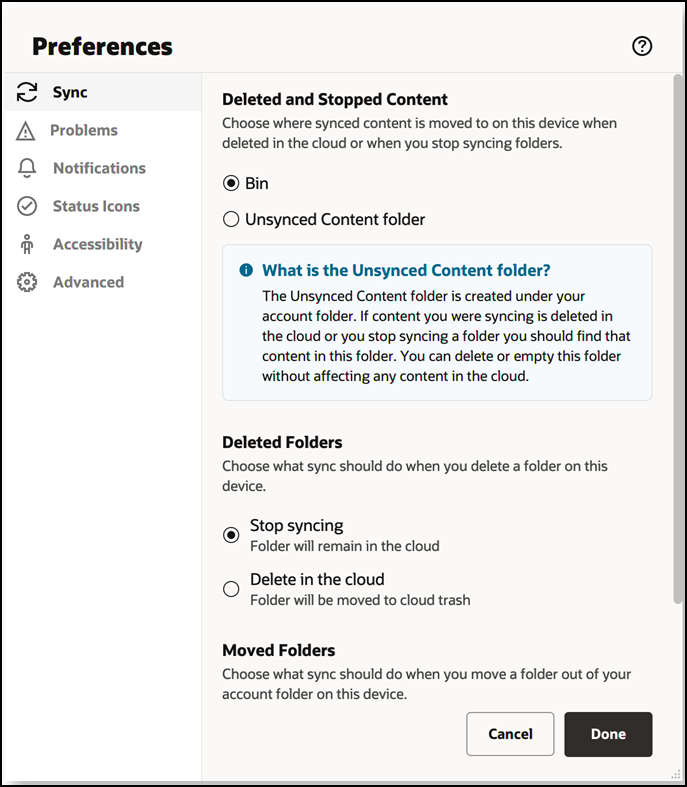
- There are new preferences for sync status icons:
- Fix missing icons by disabling and re-enabling the Oracle Content Finder extension.
- Fix missing or incorrect icons by clearing the sync status icon cache.
- Repair icons that are stuck on synchronizing.
- Select whether to update the sync activity list automatically or manually (on demand).
- The desktop app has been integrated with Windows Cloud Files, providing a richer sync status experience. In Windows Explorer, sync status is now shown in the Status column, rather than as an icon overlay on the file or folder icon. The status icons have been updated.
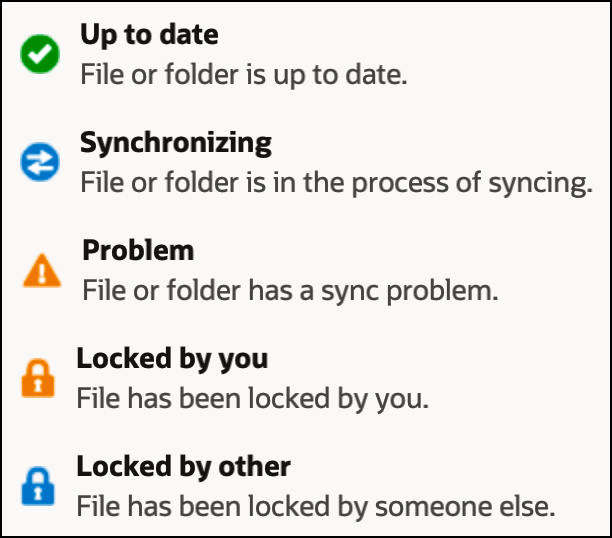
- The Accounts section now indicates when sync has been suspended for an account (for example, if your quota is exceeded or there are too many requests). When the issue is fixed, you can resume sync by selecting Resume from the account options menu. More...
- There's a new option to repair sync status icons from the Repair menu in Explorer/Finder. More...
- The REST APIs for content search now support two-level sorting of assets (using the
orderByparameter) based on a user-defined text field or an attribute in a JSON field. More... - The Embed UI API includes the following updates. More...
- The
assetsViewer,contentItemCreate, andcontentItemEditorcomponents now include apublishLateraction. - The
documentViewercomponent now includes anaddToAssetsaction.
- The
- The Oracle Content Toolkit includes the following updates. More...
- There's a new
describe-local-contentcommand, which lists local content resources. - There's a new
--namefilter(-n) option for thelist-foldercommand, which is a string to filter the results. - There are new options for the
download-foldercommand:--number(-n), which is the number of files in each batch (default: 50)--server(-s), which is the registered Oracle Content Management server
- There's a new
--query(-q) option for thetransfer-site-contentcommand, which specifies the query to fetch the assets. - There's a new
archiveaction for thecontrol-contentcommand. - There's a new
--query(-q) option for thetransfer-contentcommand, which specifies the query to fetch the assets. - There are new supported properties for the
list-assetscommand:referencesreferencedByreferencedBySites
- There are new options for the
list-assetscommand:--search(-e), which is the search query expression that matches values of the items across all fields.--searchoperator(-t), which is the search query operator (or | and) (default: or).--file(-f), which saves the results to a JSON file.
- There are new supported events for the
sync-servercommand:CONTENTITEM_CATEGORIZEDCONTENTITEM_DECATEGORIZEDDIGITALASSET_CATEGORIZEDDIGITALASSET_DECATEGORIZED
- The
index-sitecommand now includes page keywords when indexing.
- There's a new
23.7.2 — July 2023
- The smart classification feature (part of smart content) is being deprecated and will be removed from the product in the next release of Oracle Content Management.
- Email notifications now support Right-to-left (RTL).
- The Versions tab in Documents, which shows the version history for a file, now shows the version timestamp, rather than the file name, as the primary data for each version. More...
- While viewing a file in Documents, you can now add the file to an asset repository directly from the viewer, rather than having to return to the file list to do so. More...
- While viewing a digital asset, or viewing or creating a content item, you can now publish the asset directly from the viewer or editor, rather than having to return to the asset list to do so. More...
- You can now preview CSV files in Oracle Content Management. More...
- The Adobe Creative Cloud extension is now installed for all users on the machine, rather than just the current user. This means that the installing user requires administrative privileges. More...
- The REST APIs for content search now support sorting assets (using the
orderByparameter) based on a user-defined text field or an attribute in a JSON field. More... - The Oracle Content Toolkit includes the following updates. More...
- There's a new
describe-category(dsct) command, which lists the properties of a taxonomy's category on the Oracle Content Management server. - There's a new
--sourcefiles(-l) option for thecreate-templatecommand, which attempts to download files from the specified source file location. - There are new options for the
set-site-securitycommand:--addgroups(-g), which is a comma-separated list of groups to access the site.--deletegroups(-o), which is a comma-separated list of groups to remove access from the site.
- There's a new
23.7.1 — July 2023
- The Adobe Creative Cloud extension now includes icons to differentiate between standard collections and dynamic collections. More...
- You can now be notified when someone changes the membership for a folder to which you're subscribed. More...
- The Site Builder user interface for components has been updated to improve usability. More...
- The site publishing dialog includes a new option to show issues only, which shows items with "Not Ready" and "Informational" statuses that may prevent the site from publishing. This is in addition to the complete validation report, which also includes items with "Ready" status. More...

- The taxonomy Activity pane now includes export and import activities. More...
- The Asset Lifecycle webhook user interface now supports selecting to receive asset archive and restore event notifications for content items and digital assets. More...
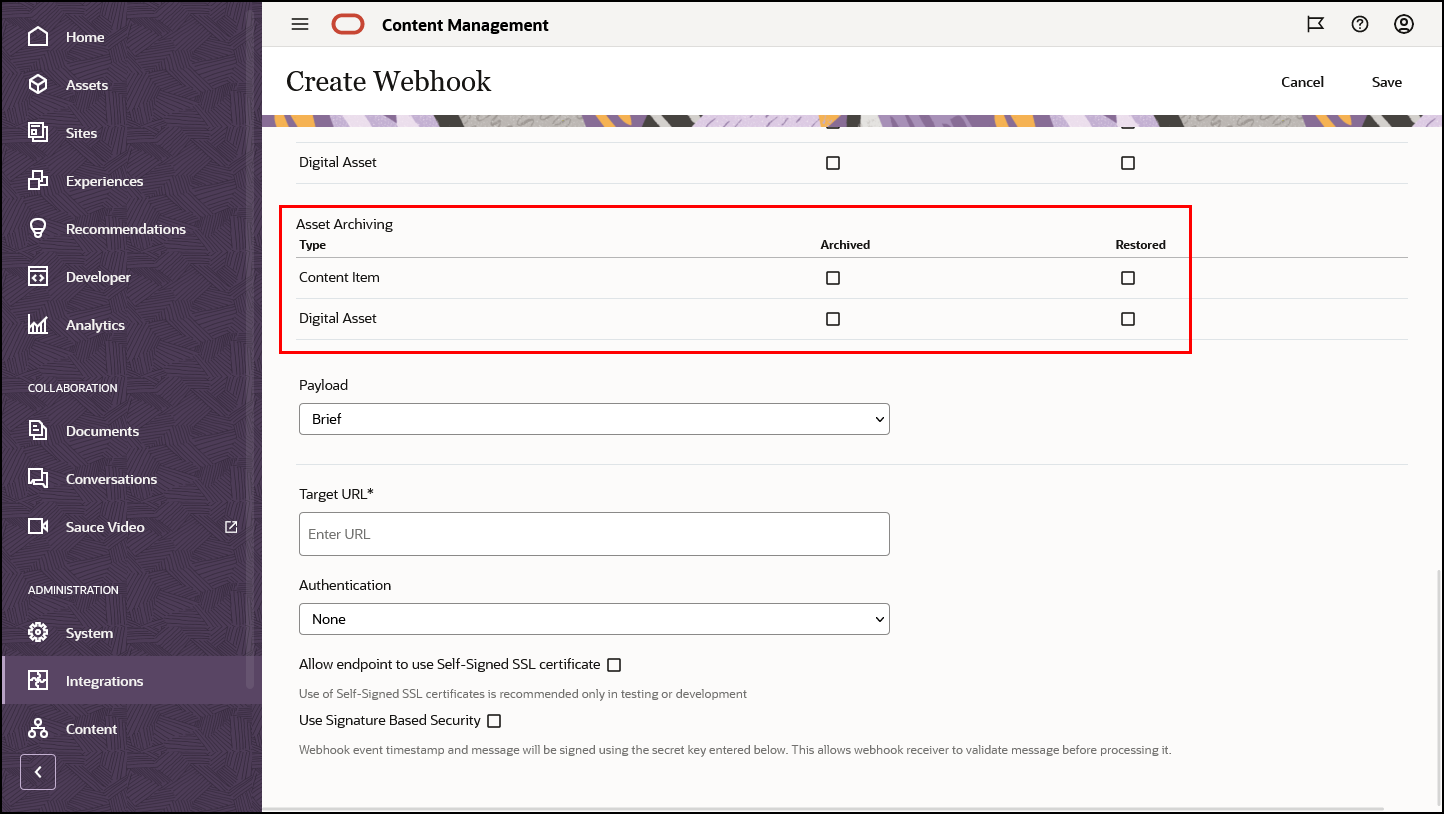
- The Oracle Content Toolkit includes the following updates. More...
- There's a new
transfer-category-property(tcp) command, which transfers category properties from one Oracle Content Management server to another. - There are new options for the
create-templatecommand:--excludetype(-t), which excludes content types.--sourcefiles(-l), which attempts to download files from the source file location.
- There are new options for the
control-sitecommand:--staticincremental(-m), which adds to the already published static files.--detailpageassets(-l), which provides the detail page ID and their asset IDs.
- There's a new
- There's new documentation describing how to integrate Oracle Content Management with Oracle Enterprise Contracts. This integration enables you to share contracts for review and revision, and collaborate on and edit contracts in Microsoft Word from the Oracle Content Management user interface. Additionally, leveraging Oracle Content Management as a cloud-based content management system streamlines content creation tasks, accelerates team collaboration, promotes content reuse from a single source (the Oracle Content Management repository), and improves customer and employee engagement. More...
23.6.2 — June 2023
- In this release of Oracle Content Management we've deprecated the CKEditor 4 plug-ins for custom content forms. If your custom content forms use these plug-ins they will still work. However, going forward, we won't make any bug fixes or enhancements to the plug-ins. We encourage you to explore using TinyMCE, the same rich text editor used in Oracle Content Management.
- You can now create rendition policies to automatically generate custom image renditions to accommodate the requirements for your various publishing channels. More...
- For each channel, you can create a rendition policy that defines the image format, quality, and size.
- You then associate one or more rendition policies with a digital asset type, and when an image is created from that asset type, your custom image renditions are automatically generated along with the standard system renditions.
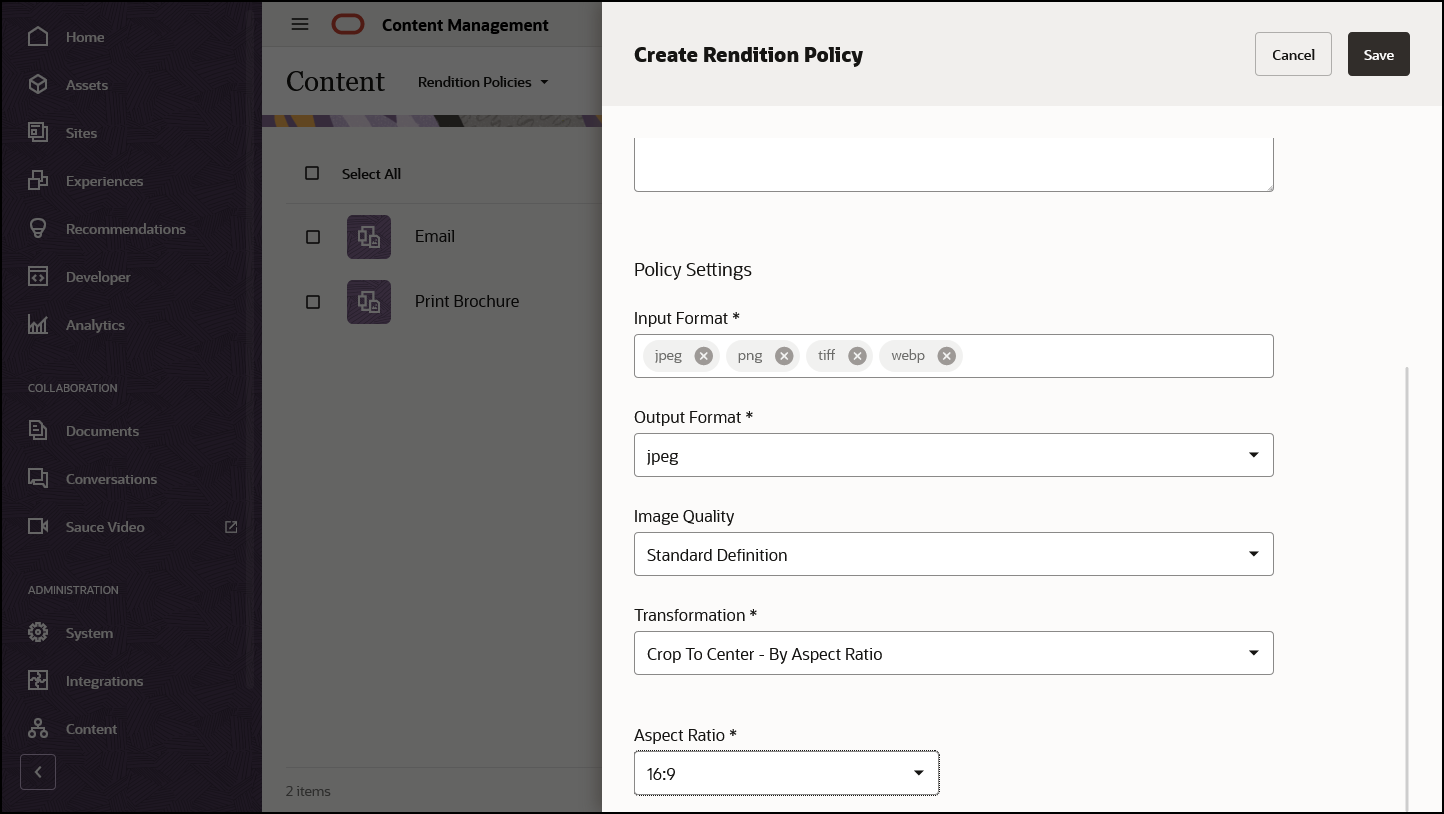
- For a published site, you can now choose to republish only selected updated pages or republish a detail page with updated or recently published assets. More...
- Taxonomies now include an Activity pane, which details specific activities performed on the taxonomy, such as taxonomy edits, category edits, promotion, repository association changes, and publishing. More...
- You can now filter the Taxonomies page to display all taxonomies or only those that you can manage or edit. More...
- External user invitations are now supported when you add members to conversations. More...
- The rich text editor used in assets now allows you to create and use anchor links in the text. More...
- If a taxonomy creator leaves your organization, the ownership of those taxonomies must be reassigned. Your service administrator can now reassign taxonomy ownership by adding the new owner as a manager of the taxonomy using cec share-taxonomy.
- The Oracle Content Toolkit includes the following updates. More...
- There's a new
--targetsite(-t) option for thetransfer-site-pagecommand, which is the target site on the destination server. - There are new options for the
control-sitecommand:--pages(-a), which is a comma-separated list of page IDs.--expand(-b), which includes all the subpages when publishing specific pages.
- There's a new
--sourcelanguage(-n) option for thecreate-translation-jobcommand, which is the source language for an assets job.
- There's a new
23.6.1 — June 2023
- In the next release of Oracle Content Management we're deprecating the CKEditor 4 plug-ins for custom content forms. If your custom content forms use these plug-ins they will still work. However, going forward, we won't make any bug fixes or enhancements to the plug-ins. We encourage you to explore using TinyMCE, the same rich text editor used in Oracle Content Management.
- External user invitations are now supported when you add members to sites. More...
- When new pages are created in a site, the default page URL is constructed with an .html extension. You can now disable this so that new pages are constructed without any extension. More...
- The Page Structure panel in Site Builder now supports inline and orphaned components. More...
- For a site import job that completes with errors, you can now retry the job after addressing the issues. More...
- You can now publish updated redirects, RSS feeds, or other auxiliary files without republishing the whole site. More...
- Content Capture integration with WebCenter Forms Recognition (WFR) via the WFR agent now allows configuration of SSL properties for data encryption and integrity. More...
- You can now create a read-only view for inbound metadata access. This enables tracking of document progress via the WFR agent. It also lets you create a view of the WFR agent database tables that you can query even after the underlying tables are modified. More...
- You can now receive asset archive event notifications via the Asset Lifecycle webhook. More...
- The Oracle Content Toolkit includes the following updates. More...
- There's a new
share-taxonomy(stx) command, which shares a taxonomy with users and groups on the Oracle Content Management server. - There's a new
unshare-taxonomy(ustc) command, which deletes user or group access to a taxonomy on the Oracle Content Management server. - There's a new
settingsfiles(-i) option for thecontrol-sitecommand, which allows you to publish only the specified site settings file(s). - There's a new
gettoken(-g) option for theregister-servercommand, which obtains the OAuth token from the server and stores it in the server JSON file.
- There's a new
- There's new documentation detailing how to migrate content from Oracle WebCenter Content, from an external repository, or from Oracle Content Management Documents to Oracle Content Management assets. More...
23.5.2 — May 2023
- Desygner is a visual content creation solution for personal and business projects. It allows designers to create templates that other teams can use to create new assets while following template rules and layouts. As a result, organizations can efficiently create and edit print-ready documents that respect the organization’s brand.
- Integrating Desygner with Oracle Content Management allows you to take advantage of the features in both applications. For instance, you can manage Desygner templates and assets directly from the Oracle Content Management web interface, leverage Oracle Content Management as a cloud-based content management system to improve team collaboration, streamline content creation and publication, and promote content reuse from a single source (an Oracle Content Management repository). More...

- Import Desygner templates into Oracle Content Management and edit them. More...
- Create, edit, and publish Desygner assets in Oracle Content Management. More...
- External users no longer need to be manually provisioned before users can invite them to collaborate on content. Users can invite new external users simply by adding them to folder membership with their email addresses. If there isn't already a user with that email address, you'll be asked for additional information, such as their name and location, then you can invite them, and Oracle Content Management will automatically provision a new external user. This functionality will be expanded to sites and conversations membership in the future. More...
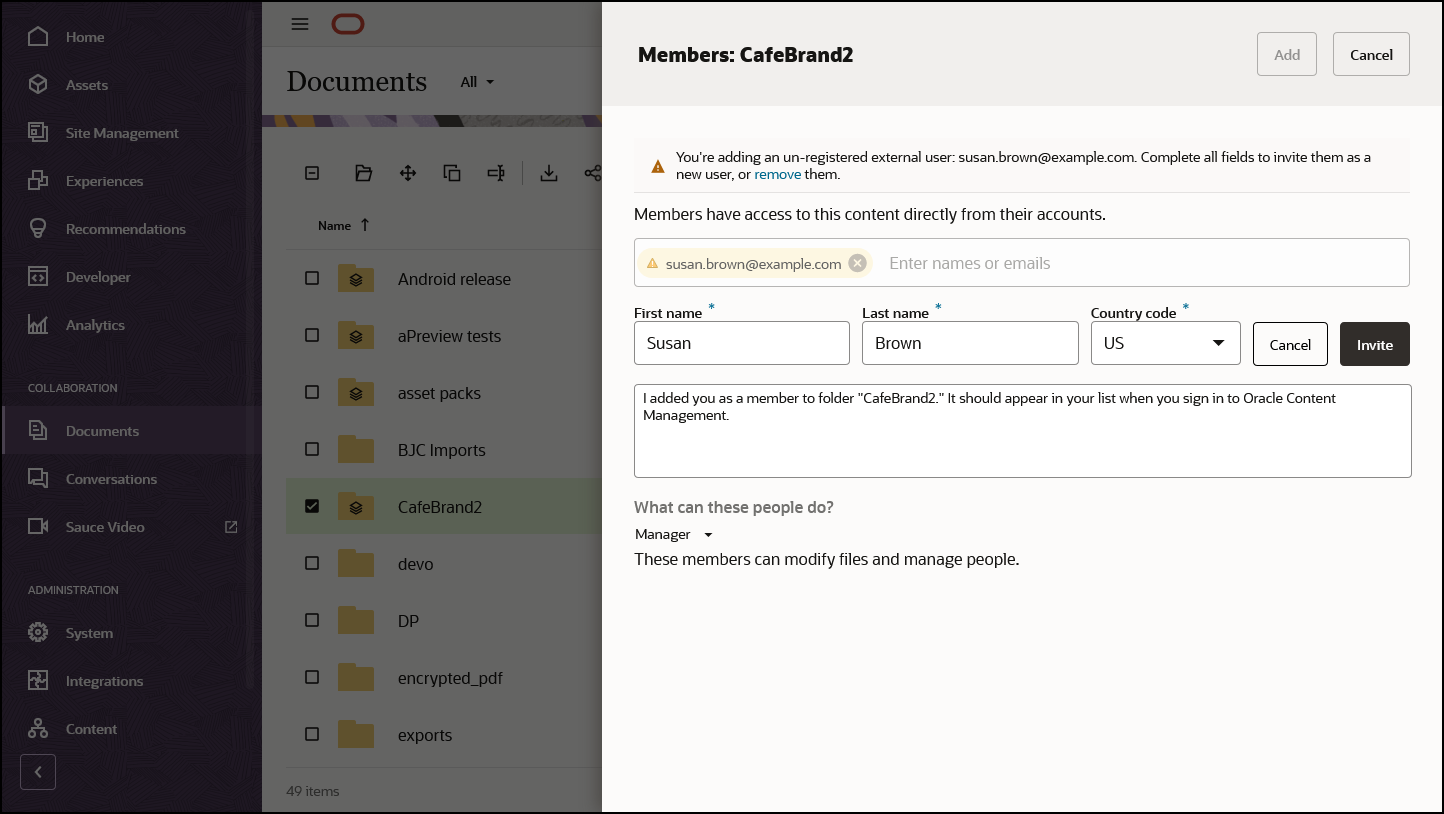
- New administrative controls enable you to restrict the creation of external users from unwanted domains. More...
- Type-ahead search results are no longer available for external users. When users add an external user as a member of an object, they must enter their full email address.
- If you have a federated identity provider, you can redirect external user invitation requests through your own identity provider. More...
- Configure the number of days after which external user invitations expire. More...
- The more actions icon (
 ) in the page actions has been replaced with a More Actions button.
) in the page actions has been replaced with a More Actions button.
- Content Capture administrators now need to specify the number of files to be imported per batch for both per list file and per folder import options. For both options, the default and maximum value of files that can be imported per batch is 500. If the number of files is greater than the maximum files per batch value, then multiple batches are created. More...
- The new Sites Component API allows you to create components that can be used on a site page rendered dynamically in the browser or during compile to generate static pages for delivery.
- Three new samples for headless Oracle Content Management have been published. More...
- Build an Image Gallery in Java for Android
- Build a Blog App for Android
- Build a Blog App in Swift for iOS
- The Oracle Content Toolkit includes the following updates. More...
- There's a new
retry-import-jobcommand, which retries to perform an import job. - There's a new
list-asset-idscommand, which lists the IDs of assets in an Oracle Content Management server. - There are new actions for the
control-contentcommand:submit-for-review,approve, andreject.
- There's a new
- The Sites SDK documentation has been moved from an appendix in Building Sites with Oracle Content Management to its own document.
23.5.1 — May 2023
- Asset users can now use a dynamic collection, based on a complex asset search created by an asset expert, to filter assets that are relevant for a specific business task or their day-to-day activities. More...
- Asset experts can create dynamic collections by defining complex asset search queries, choosing data fields, search operators, and values. They then share those dynamic collections so other users can quickly and easily find what they need. More...
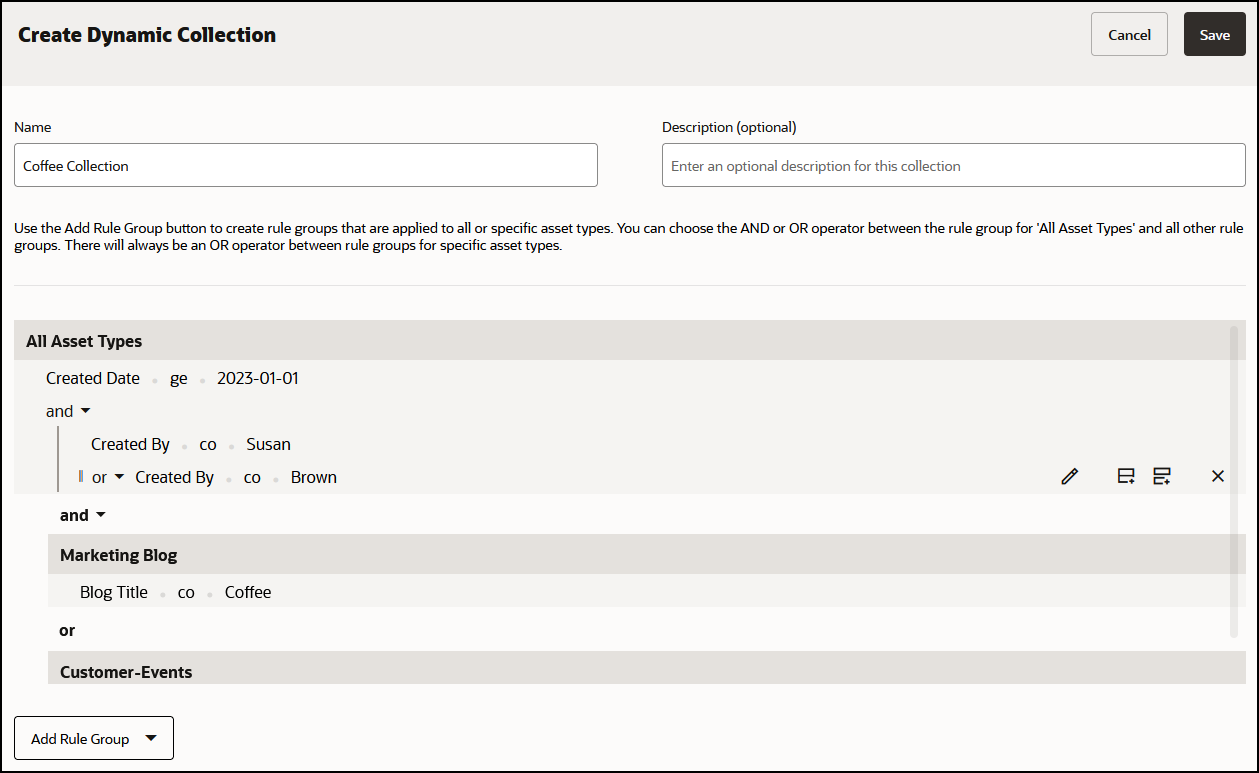
- You can now control who can edit, promote, publish, or delete specific taxonomies by adding members to the taxonomy as Managers or Editors. More...
- The Content Search API maximum page size for returning matching items is now limited to 500.
- The Oracle Content Toolkit includes the following updates. More...
- There is a new
create-site-page(csp) command, which creates a new site page and adds it to a site. - There is a new
describe-site-page(dssp) command, which lists the properties of a site page. - There is a new
--file(-f) option for thevalidate-sitecommand, which is the file to save the results to. - There is a new
--file(-f) option for thevalidate-assetscommand, which is the file to save the results to.
- There is a new
23.4.2 — April 2023
- Oracle Content Management now allows you to export a site with all its dependent objects and published assets, even large sites with tens of thousands of pages and assets. The export archive is created in a Documents folder and is automatically partitioned to account for a potentially large sites. More...
- You can then import the archive, creating a new site, or updating or duplicating an existing one.
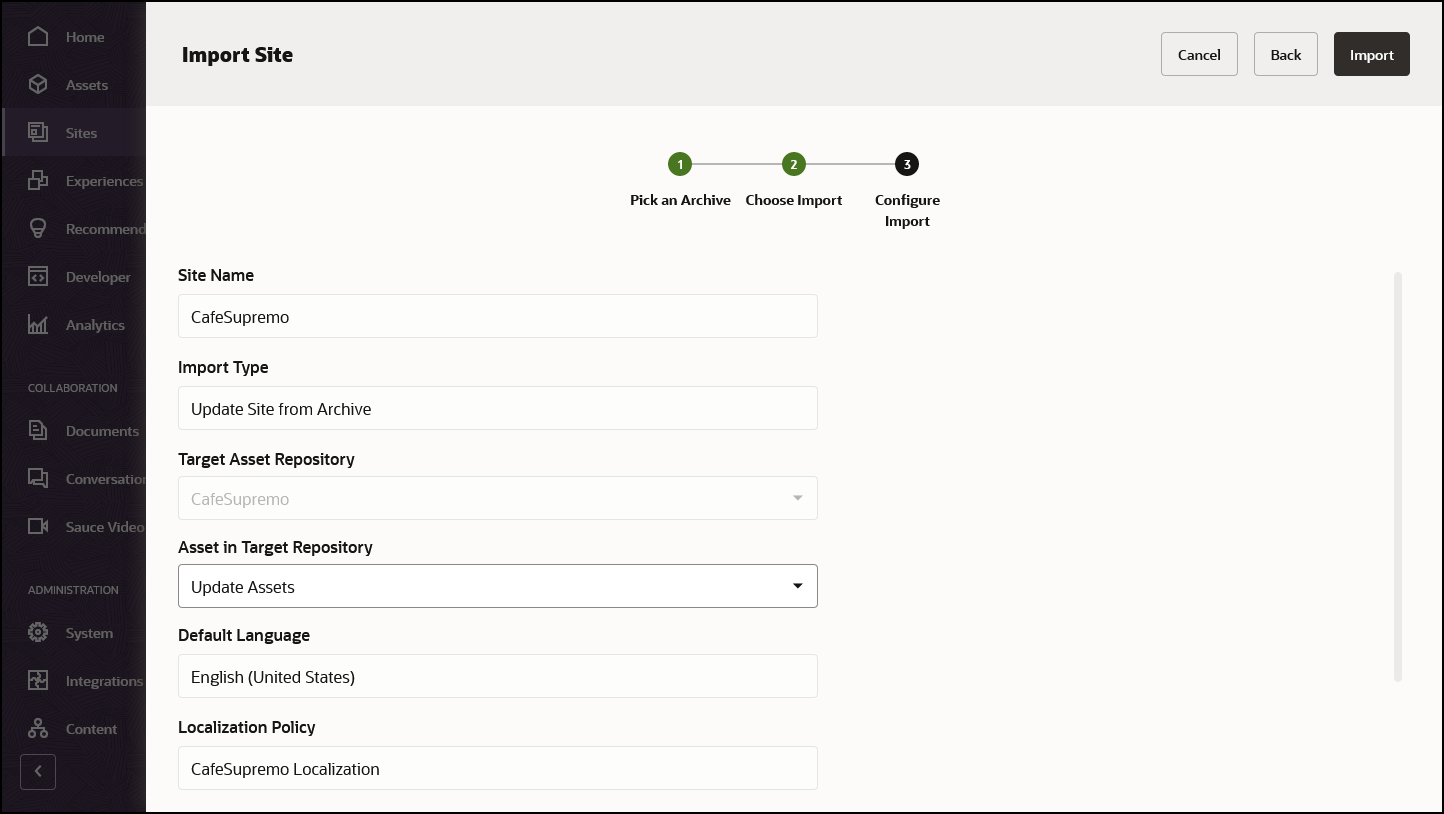
- Both site export and import include validation to ensure that all the dependencies are properly resolved and that you have permission to access them during export or permission to create or update them during import.
- The new Export Jobs and Import Jobs pages allow you to track export and import jobs that run in the background and access a validation report or summary log for a job.
- The sidebar panel toggle icon now includes a directional indicator to show whether you're opening or closing the panel.
- For lists that span multiple pages, the pagination controls are now fixed to the bottom so you don't have to scroll to the bottom of the page to access them.
- Content Capture now supports importing multi-line fields. More...
- You can now manage Adobe projects in the extension's Assets and Documents views, opening, editing, and saving them directly from or to a repository. More...
- You can now control whether a repository includes implicit view access to all its collections or if users must be explicitly granted the Viewer role or higher on individual collections. More...
- You can now add an image to use as the favicon in browser tabs where the web client is open. More...
- A new tutorial is available that explains how to build an image viewer using Swift for iOS, with Oracle Content Management as the content management system (CMS) and its Content SDK. More...
- There is a new Content SDK for Java, which is a library that interacts with the Content REST Delivery APIs. This library provides data models and APIs to read structured content and digital assets from Oracle Content Management.
The Content SDK for Java is made available as an Oracle open-source project on GitHub.
- The Oracle Content Toolkit includes the following updates. More...
- There are new commands related to importing and exporting sites:
export-siteimport-siteunblock-import-jobcancel-export-jobcancel-import-jobdelete-export-jobdelete-import-joblist-export-jobsdescribe-export-joblist-import-jobsdescribe-import-job
- There is a new
transfer-editorial-rolecommand, which transfers editorial roles from one Oracle Content Management server to another. - There are new source values for the
create-componentcommand:local-preactandlocal-react.
- There are new commands related to importing and exporting sites:
23.4.1 — April 2023
- Site properties now include an Activity tab, which shows recent site activity. More...
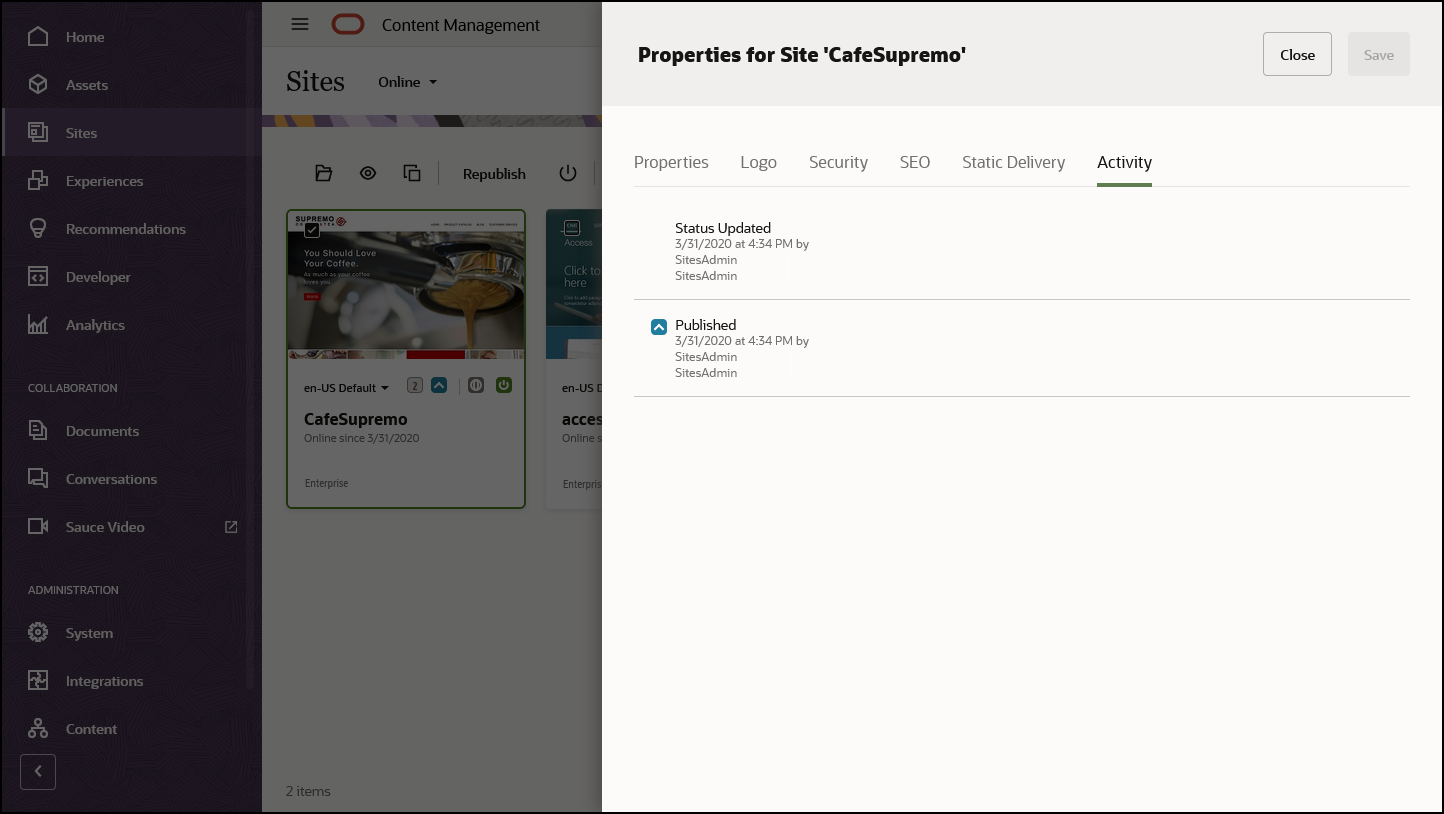
- The Custom Content Form SDK object includes a new
sdk.canCreateAsset(options)method, which specifies whether or not the asset of a given type can be created. More... - There is a new Content SDK for Swift, which is a Swift package of libraries that interact with the Content REST APIs. These libraries provide access to structured content and digital assets that are managed in Oracle Content Management. There are two main libraries:
- OracleContentDelivery, which provides data models and APIs for consuming content from Oracle Content Management.
- OracleContentCore, which provides base functionality, including network transport capabilities, that’s shared and required by multiple Oracle Content libraries.
The Content SDK for Swift is made available as an Oracle open-source project on GitHub.
- The Oracle Content Toolkit includes the following updates. More...
- There is a new
--useFallbackLocale(-f) option for thecompile-templatecommand, which specifies the locale of the page file to use if the selected locale page file doesn’t exist. - There is a new
--validate(-v) option for thelist-server-content-typescommand, which validates custom field editors in types. - The
list-activitiescommand now supports two new resource types:channelandrepository.
- There is a new
23.3.3 — March 2023
- Oracle Content Management now provides native disaster recovery as an add-on product service option. More...
- Provides full application recovery: Oracle Content Management disaster recovery provides recovery for the entire application stack, which includes the components such as database, search indexes, object storage, and the application tier. This full-stack disaster recovery allows for business continuity that depends on recovering the entire application stack instead of a few select components.
- Minimizes disaster recovery time: Oracle Content Management disaster recovery eliminates the need to perform manual disaster recovery for individual resources.
- Eliminates the need for special skills: The operators and administrators don't require any special skills or domain expertise in areas such as applications and storage replication.
- Single pane of glass monitoring and management: Oracle Content Management disaster recovery provides a single pane of glass monitoring and management capability for all Oracle Content Management disaster recovery enabled instances. You can create disaster recovery instances, monitor disaster recovery readiness and check status using the Oracle Cloud Console.
- You can no longer delete locked files. More...
- You can now automate the detection of languages and classification of documents when the documents are received in Capture. More...
- GraphQL now supports sorting by
createdDateandupdatedDateinstandardSorttype for thegetItemsquery. - The Oracle Content Toolkit includes the following updates. More...
- There is a new
restore-trash(rtr) command, which restores a resource in trash on the Oracle Content Management server. - There is a new
xml-variantsformat value for theindex-sitecommand, which includes language and region variants in a site map. - The
transfer-site-pagecommand now supports transferring new pages to the destination server.
- There is a new
23.3.2 — March 2023
- The app downloads and the Download Apps pages have been reorganized. More...
- The Content Capture Client installer is now available on the Windows page.
- The Adobe Creative Cloud extension is no longer part of the desktop app install; it has its own installer. Download the new version on the Windows or macOS pages.
- The Sauce Video mobile apps are now available on the iOS and Android pages.
- The Design tab in the left sidebar has been removed, and the settings on that tab have been moved. The Background settings have been moved to a Background tab in the Page Settings. The Theme picker has been moved to the Site Settings.
- The annotation controls have been moved from the main toolbar to a toolbar in the settings panel.
- There is a new Page Structure tab in the left sidebar, which enables you to inspect the page structure hierarchy and reposition components.
- The page and component settings now open in a panel on the right that stays open when you select another page or component. More...

- The Oracle Content Toolkit includes the following updates. More...
- There is a new
list-trash(ltr) command, which displays content in the Trash on the Oracle Content Management server. - There is a new
delete-trashcommand, which permanently deletes a resource from the Trash on the Oracle Content Management server. - There is a new
empty-trashcommand, which deletes content in the Trash on the Oracle Content Management server. - There is a new
config-properties(cp) command, which lists configuration properties for the Oracle Content Management server. - There is a new
list-activities(lac) command, which lists activities on the Oracle Content Management server.
- There is a new
23.3.1 — March 2023
- Oracle Content Management's (OCM) new content apps platform allows you to discover and deploy web applications that run in the context of OCM (using it as the content management system). You can use the apps framework to create custom solutions that extend the features of OCM to suit your user scenarios. More...
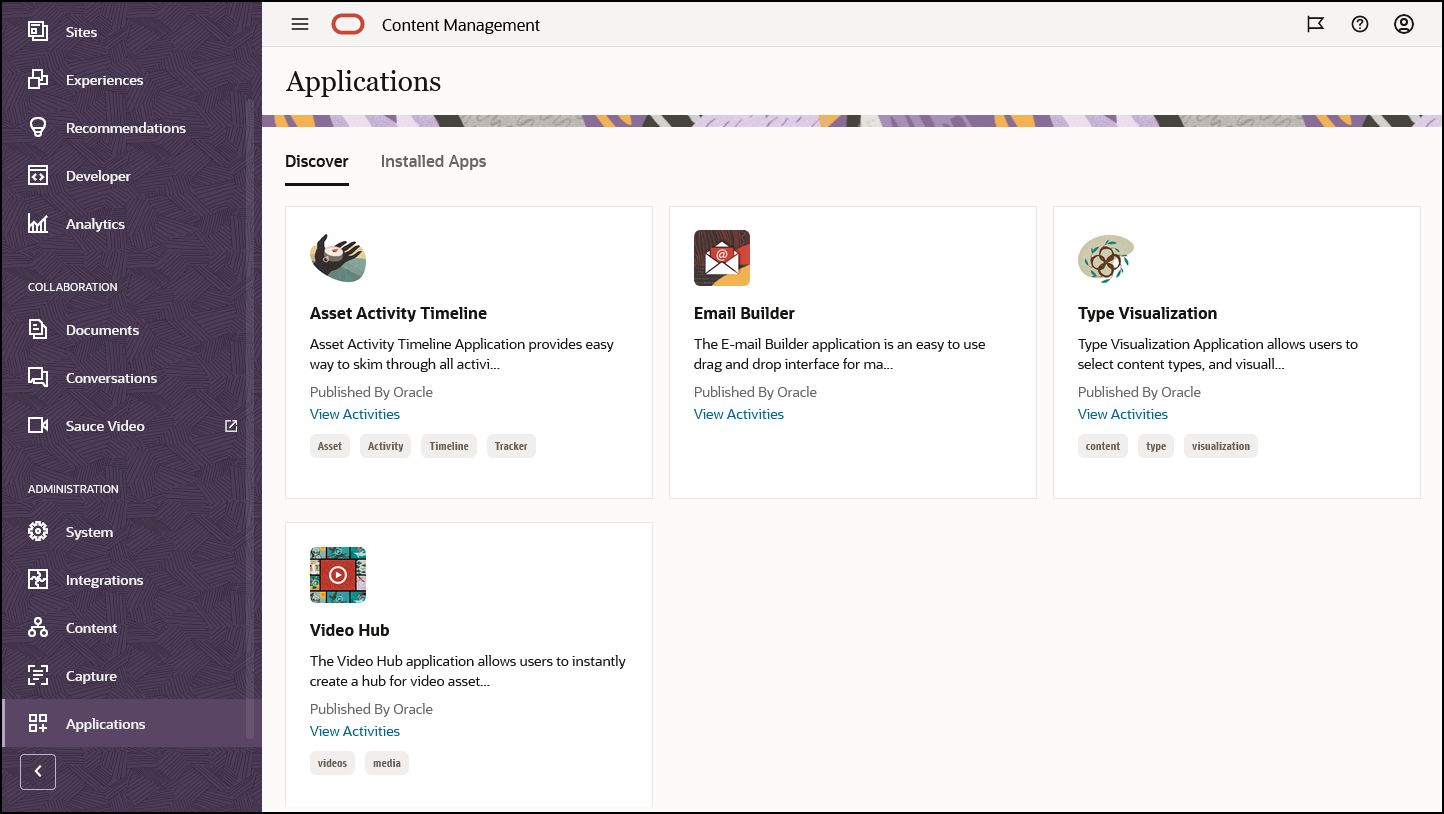
- The Applications page (available in the left navigation menu) provides access to everything you need for using and deploying content apps. Discover all available apps, both pre-built apps and custom apps. View the apps that are currently installed on your OCM instance.
- The application portal includes some pre-built demo and sample apps:
- Email Builder App—The Email Builder app provides an easy-to-use, drag-and-drop interface for marketers to create e-mails that can be downloaded for use with e-mail campaign management tools of your choice, including Oracle Responsys. More...
- Video Hub App—The Video Hub app enables you to easily organize, sort, browse, and search your collection of advanced videos hosted in OCM. More...
- Asset Activity Timeline App—The Asset Activity Timeline app is a one-stop solution that lets you track all the activities of an asset and filter the activities based on your preferences.
- Type Visualization App—The Type Visualization app lets you select content types, and then view and evaluate the content in a visual representation. The visualization not only showcases the additions of data fields, but also relationships between each referenced type, and provides insights into the number of repositories where assets were added.
- For Video components, you can now select digital assets for the preview image. More...
- You can now be notified by Slack when someone shares an Oracle Content Management file or folder using the Slack App or shares from the Oracle Content Management web application to Slack. More...
- You can now select failed batches in the Content Capture Client and release them to the same process. More...
- The GraphQL tutorials for React and Vue have been updated. More...
- The Oracle Content Toolkit includes the following updates. More...
- There is a new
transfer-site-pagecommand, which transfers site pages from one Oracle Content Management server to another. - There is a new
--days(-n) option for thesync-servercommand, which is the number of days to keep processed events. All webhook events are saved in an event.json file. When the sync server is started, the events that were processed seven days ago will be deleted by default, but you can override that by setting the--days (-n)(-n) option.
- There is a new
- The Oracle Sales Accelerator documentation is now included in Oracle Content Management Help Center.
23.2.2 — February 2023
- If OCI services content sharing and smart content are enabled, Oracle Content Management now automatically generates transcripts for English language .mp4 and .mkv videos. More...

- You can search for videos based on the content of the video transcript.
- When you play a video with the transcript, lines in the transcript are highlighted as the video plays.
- When you click a line in the transcript, you skip to that spot in the video, and vice versa.
- You can search the transcript, jumping directly to the resulting line in the transcript and associated spot in the video.
- When viewing objects (such as assets, documents, or sites) in table view, you can now customize which columns appear.
- Asset viewing has been streamlined by combining open and preview functions into a single view. More...
- The Taxonomy page includes new draft, promoted, and published indicators. More...
- The email message and attachment import functionality of the import processor now supports Microsoft Graph API. More...
- The Content Field Editor and the Custom Content Form include a new
getDirectionmethod, which gets the current direction of the user interface. - The Embed UI API includes the following updates.
- The
assetsViewcomponent has been updated. Theopenaction was removed and theviewaction was added. More... - The
assetViewercomponent has been updated. Thesavebutton and theopenaction in the content header were removed. More... - The
archivedAssetsdialog has been updated. Theopenaction was removed and theviewaction was added. More... - The
assetLanguagesdialog has been updated. Thepreviewaction was removed and theviewaction was added. More...
- The
- The Oracle Content Toolkit includes the following updates. More...
- The Oracle Content Toolkit Command-Line Utility documentation now includes a What's New section.
- The
update-templatecommand includes a new--server(-s) option, which allows you to specify a template on an Oracle Content Management server. - The
update-templatecommand, includes newrequire-taxonomyandnot-require-taxonomyactions, which allow you to specify whether templates require the site security taxonomy. - The
create-site-mapcommand includes a new--excludelanguages(-x) option, which allows you to exclude a comma-separated list of languages from the site map. - The
control-contentcommand includes the following new options:--assetsfile(-f), which is a file with an array of the asset GUIDs--batchsize(-b), which is the number of assets in each batch to publish in batches--execute(-e), which executes the publish script when publishing in batches
- The
list-assetscommand includes a new--properties(-p) option, which allows you to show the properties of assets.
23.2.1 — February 2023
- You can now easily create hundreds of sites that share the same asset repository while still controlling access to site-specific content. For example, site contributors would be able to access common assets such as corporate logos and assets intended for use on sites they manage, but not have access to assets intended for other sites. More...
- You start by creating a taxonomy specifically for site security and assigning it to the shared repository. A site developer creates a template that requires the use of a site security taxonomy. When a user creates a site from that template and selects the shared repository, Oracle Content Management automatically adds a new site category to the taxonomy and creates groups for site viewers and site contributors.
- You don't need to manually assign the site category to assets. Any assets added to the site will automatically be categorized with the site category.
- You don't need to manually assign permissions to site content. When the site is shared with someone, they will automatically be added to the appropriate site group, based on the role they're given.
- Oracle Content Management now supports previewing .svg files in the mobile apps.
- View the history and details of all past site publishing jobs on the new Publishing Jobs page. More...
- You can now allow multiple versions of the Content Capture client to run in parallel for a period of time, allowing users to update immediately or at a later date.
- You can now configure outbound webhooks to send a hash-based message authentication (HMAC) token for signature verification. More...
- The Oracle Content Toolkit includes the following updates. More...
- There is a new
update-taxonomycommand, which updates a taxonomy on the Oracle Content Management server. - The
create-sitecommand includes a new--category(-c) option, which is the category path of the parent category for site security management. - The
set-editorial-permissioncommand includes a newcreateSitepermission for taxonomies, which allows users to create sites using a taxonomy category as the parent category for site content.
- There is a new
- The documentation includes new guidance on the key activities needed to provision and configure Oracle Content Management as a digital asset management hub. More...
23.1.2 — January 2023
- Microsoft Office O365 files now open in a new tab.
- Site managers can now access a site's files directly from the Properties panel. More...
- The Site Builder user interface has been updated to improve site contributors' user experience.
- There is a new Oracle Content Management plug-in that enables you to use TinyMCE in a custom content form. More...
- The Oracle Content Toolkit includes the following updates. More...
- The
describe-componentcommand has been extended to include a list of all sites where a component is used. - The
update-sitecommand includes a new--compilationjob(-c) option, which updates a site's compilation job data using the JSON data provided. - The
create-asset-reportcommand includes a new--pages(-p) option, which specifies the pages to include in the report.
- The
23.1.1 — January 2023
This release includes security and stability improvements.
22.12.2 — December 2022
- IMPORTANT: Due to a change in upgrade detection, previous releases of the desktop client won't notify users of the new release when they start the desktop client or if they check for updates. If you don't deploy your own installation package, you must tell users to manually download and upgrade to the new desktop client. More...
- When you synchronize a shared folder, it no longer includes the owner's name in the folder name, keeping the path names shorter. This information can now be found in the Comments column in your local account folder. More...
- You can once again share files while they are still being scanned. More...
- The desktop client has been updated to improve stability.
- The Oracle Content Toolkit includes the following updates. More...
- The new
refresh-oauth-tokencommand allows you to refresh the OAuth token from the Oracle Content Management server. - The
control-repositorycommand includes newenable-not-readyanddisable-not-readyactions to configure whether a repository allows assets to be saved in a "Not Ready" status (with default or missing values in required fields). - The
describe-taxonomycommand includes a new--id(-i) option to include the taxonomy ID.
- The new
- There is a new topic for integrating with Oracle Commerce. More...
22.12.1 — December 2022
- IMPORTANT: Due to a change in upgrade detection, previous releases of the desktop client won't notify users of the new release when they start the desktop client or if they check for updates. If you don't deploy your own installation package, you must tell users to manually download and upgrade to the new desktop client. More...
- You can now bookmark an asset search. More...
- You can now preview any current version of a taxonomy—draft, promoted, or published. More...
- The zoom range in the image editor has been increased to support larger images.
- The clickable area around checkboxes in list views has been increased to make it easier to select multiple items.
- You can now revoke the translation connector access token generated in the 2-legged OAuth flow. More...
- The Oracle Content Toolkit includes the following updates. More...
- The
describe-background-jobcommand now includes a--wait(-w) option, which waits for the job to finish if the job is still in progress. - The
create-site-mapcommand now includes a--default-locale(-d) option, which includes the default locale in the URLs, and a--usedefaultsiteurl(-e) option, which uses '/' for the root page path instead of any pageUrl value.
- The
- The blog sample for Oracle JET was updated to use the latest Virtual DOM (VDOM) architecture. More...
- A new tutorial is available on how to localize the Vue minimal site sample so it supports multiple languages. More...
22.11.2 — November 2022
- IMPORTANT: Due to a change in upgrade detection, previous releases of the desktop client won't notify users of the new release when they start the desktop client or if they check for updates. If you don't deploy your own installation package, you must tell users to manually download and upgrade to the new desktop client. More...
- The Untouched Documents report is now sorted by days untouched, and all columns are sortable. More...
- You can now limit the notifications sent from an Asset Lifecycle webhook to selected asset types in the repository. More...
- The Oracle Content Toolkit includes the following updates. More...
- There is a new
describe-typecommand, which lists the properties of an asset type. - The
create-site-mapcommand includes a new--multiple(-m) option, which creates one site map for each locale to support fallback languages.
- There is a new
- There are new headless samples and tutorials for minimal, blog, and image gallery for React Native. More...
- There is a new topic for using APIs for extended workflow. More...
22.11.1 — November 2022
- IMPORTANT: Due to a change in upgrade detection, previous releases of the desktop client won't notify users of the new release when they start the desktop client or if they check for updates. If you don't deploy your own installation package, you must tell users to manually download and upgrade to the new desktop client. More...
- Oracle Content Management now supports a new rich text editor based on TinyMCE. The new editor replaces the previously used CKEditor 4 in Site Builder (paragraph and title components, and in-line text), content form editing (long text field), annotations, and conversations.
- This change is transparent to users; the format and editing of rich text remains the same.
- This change doesn't affect any CKEditor that you may use in your custom content forms or field editors as long as your custom component is loading CKEditor from a third-party CDN. Oracle Content Management continues to support custom plugins (image and link) for CKEditor in custom content forms or field editors, allowing you to continue using the Oracle Content Management asset picker and link dialog in the CKEditor.
- Managing Assets with Oracle Content Management has been restructured to more clearly differentiate between managing digital assets and business assets. More...
22.10.1 — October 2022
- IMPORTANT: Due to a change in upgrade detection, previous releases of the desktop client won't notify users of the new release when they start the desktop client or if they check for updates. If you don't deploy your own installation package, you must tell users to manually download and upgrade to the new desktop client. More...
- The new desktop client release requires users to sign in using their default desktop browser. After signing in, they can close the browser window.
- Users' existing authentication tokens will remain valid for a while so they won't have to sign in immediately after upgrade, but within a week the existing tokens will expire, and users will be notified that they need to sign in.
- If you deploy your own installation package you can use a
-reloginparameter when launching the client to force the user to sign in as part of the upgrade process. This is required only for this release because the change in the format of the authentication refresh token means that the user's existing access token won't automatically renew. More... - Microsoft Windows 11 users will see a new context menu in Windows Explorer for files and folders which groups all Oracle Content options together in a submenu. More...
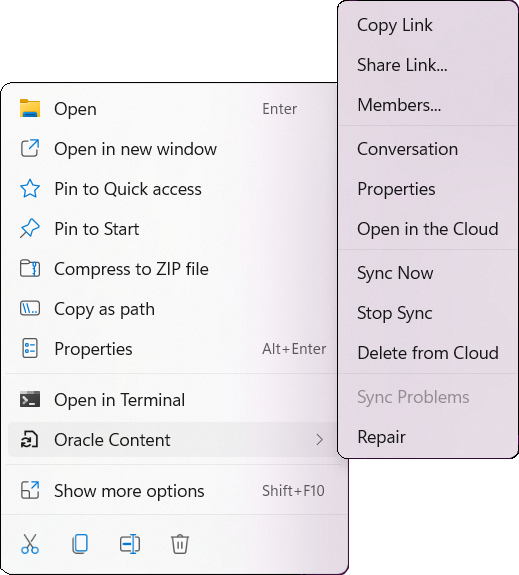
- In November Oracle Content Management will support a new rich text editor based on TinyMCE. The new editor will replace the currently used CKEditor 4 in Site Builder (paragraph and title components, and in-line text), content form editing (long text field), annotations, and conversations.
- This change will be transparent to users; the format and editing of rich text will remain the same.
- This change won't affect any CKEditor that you may use in your custom content forms or field editors as long as your custom component is loading CKEditor from a third-party CDN. Oracle Content Management will continue to support custom plugins (image and link) for CKEditor in custom content forms or field editors, allowing you to continue using the Oracle Content Management asset picker and link dialog in the CKEditor.
- You can now view a validation report prior to publishing assets. More...
- Like the desktop client app, the extension now requires users to sign in using their default desktop browser. After signing in, the user can close the browser window.
- The extension includes several improvements to workflow.

- Basic authentication in Microsoft Exchange Online is being deprecated for IMAP and EWS protocols. For more information, see Deprecation of Basic authentication in Exchange Online. We recommend switching to OAuth authentication at your earliest convenience.
- Version 11 of the Saxon XML processing engine for Content Capture is now available in this release of Oracle Content Management. In the March 2023 release of Oracle Content Management, version 10 of the Saxon XML processing engine for Content Capture will no longer be available for use. If you use version 10 currently, you should start transitioning to version 11 before March 2023 to ensure there will be no issues in your Capture procedures or batches in March 2023.
- Signature-based security is now available to authenticate the call between your service and Oracle Content Management when event notifications are sent to your webhook endpoints. More...
- The Oracle Content Toolkit includes the following updates. More...
- There is a new
describe-filecommand, which lists the properties of a file in Oracle Content Management. - The
download-filecommand includes a new--fileversion(-v) option so you can download a specific version of a file. - The
upload-static-site-filescommand includes new options. The--zipfile(-z) option zips up the static files before upload, so that only one file needs to be uploaded. The--folder(-c) option copies the processed static files to the local folder without uploading them. - The
upload-contentcommand includes a new--publish(-b) option, which publishes content after import.
- There is a new
- Analytics includes a new Untouched Documents report, which lists the documents that haven't been touched for a specified period. More...
22.9.3 — September 2022
- In November Oracle Content Management will release a new desktop client. This new release will require users to sign in using their default desktop browser. After signing in, the user can close the browser window.
- Users existing authentication tokens will remain valid for a time so they won't have to sign in immediately after upgrade, but within a week the existing tokens will expire, and users will be notified that they need to sign in.
- If you deploy your own installation package you can use a
-reloginparameter when launching the client to force the user to sign in as part of the upgrade process.
- In November Oracle Content Management will support a new rich text editor based on TinyMCE. The new editor will replace the currently used CKEditor 4 in Site Builder (paragraph and title components, and in-line text), content form editing (long text field), annotations, and conversations.
- This change will be transparent to users; the format and editing of rich text will remain the same.
- This change won't affect any CKEditor that you may use in your custom content forms or field editors as long as your custom component is loading CKEditor from a third-party CDN. Oracle Content Management will continue to support custom plugins (image and link) for CKEditor in custom content forms or field editors, allowing you to continue using the Oracle Content Management asset picker and link dialog in the CKEditor.
- Your service administrator can configure Oracle Content Management to integrate with Slack. More...
- The Slack app integration enables users to post links to files and folders into Slack messages directly, without having to first create the links in the Oracle Content Management web interface and copy them into Slack. More...
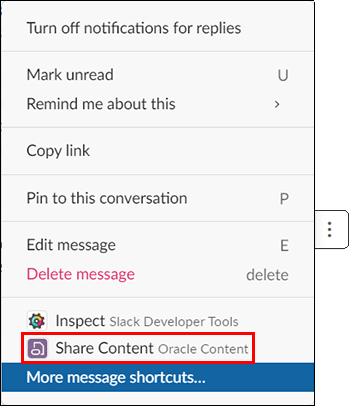
- Oracle Content Management mobile apps now support Apple iOS 16. More...
- The Embed UI API V2 now includes a documentsSearch component. More...
- The Asset Lifecycle Webhook now allows you to select individual events for asset translation. More...
- You can now use a query to search assets for text in any field, including the asset's native binary file when using a type-specific search. More...
- The Oracle Content Toolkit includes the following updates. More...
- There are new
upload-localization-policyanddownload-localization-policycommands. - The
create-site-mapcommand now includes atextformat option. - The
control-contentcommand now includes aset-translatedaction.
- There are new
- You can now allow users to email an administrator if they believe a file they tried to upload has been falsely marked as infected. If the administrator determines the file is safe for upload, they can specify that the virus scan results be ignored for the file. More...
22.9.2 — September 2022
- You can now configure path as a data type in your metadata. Conditional assignment jobs can be configured to perform specific processing on path metadata fields to include parsing and setting of values. Path fields can also be used in taxonomy lookup jobs to locate or create path matching categories in an Oracle Content Management taxonomy. The categories found or created can be used during Content Capture commit operations in both business asset repositories and standard asset repositories. The path field can also be used to match folder structures when Content Capture is configured to commit to Oracle Content Management documents. More...
- The Oracle Content Toolkit includes the following updates. More...
- There is a new
list-publishing-jobscommand to list publishing jobs for sites, components, themes and assets. - There is a new
download-job-logcommand to download a publishing job log.
- There is a new
22.9.1 — September 2022
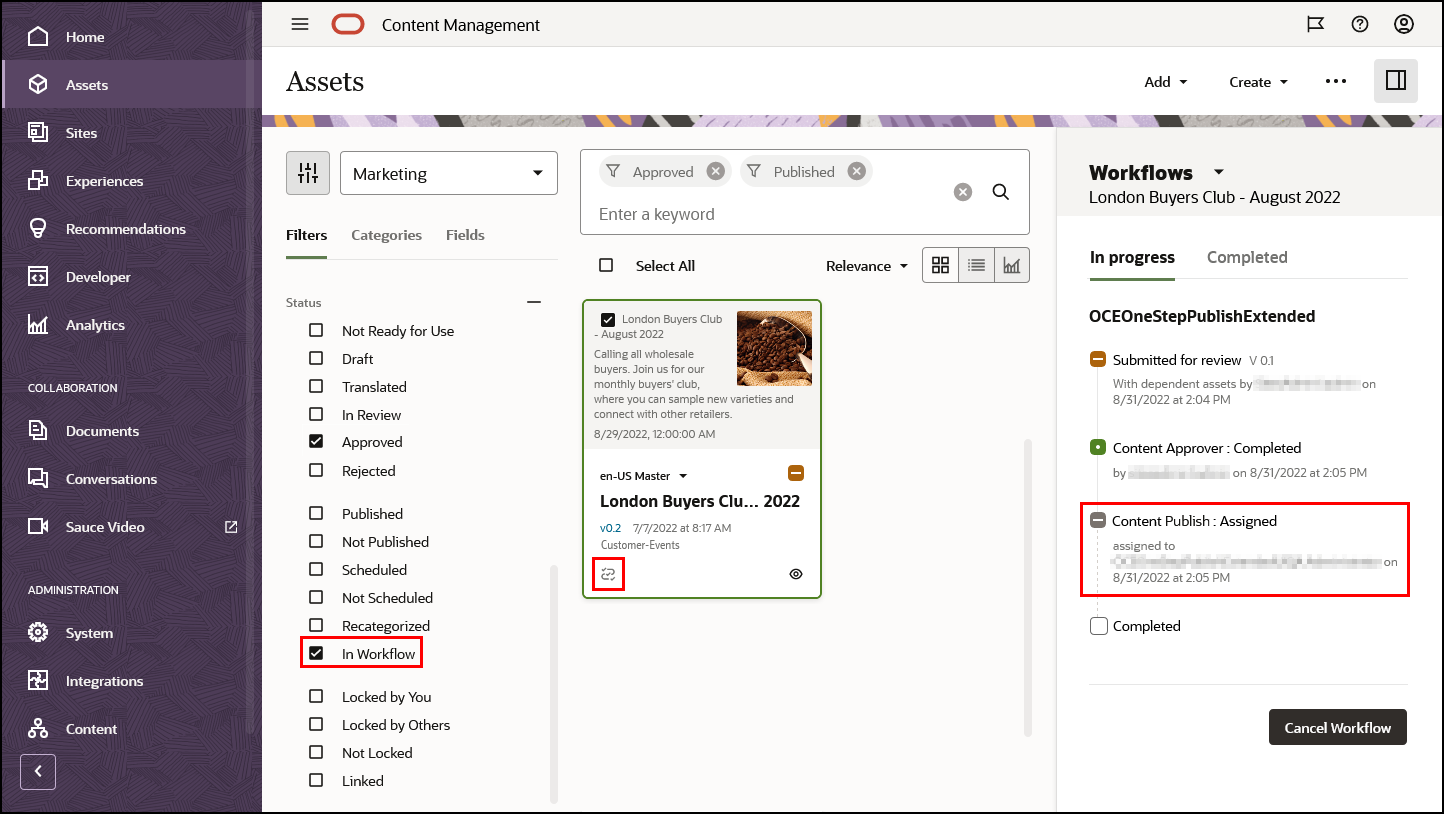
- Now you can now use workflow processes that extend beyond asset approval, enabling you to complete additional workflow actions such as submitting the asset for publishing.. More...
- You can use the new "One-Step Content Approval and Publish with Extended Workflow" sample available with the other seeded content workflows in the quick start application package. More...
- When an asset is in workflow, a workflow icon (
 ) is shown on the asset tile. More...
) is shown on the asset tile. More... - Users can find assets with extended workflow with a new "In Workflow" filter on the Assets page. More...
- You can now configure language as a data type in your metadata to enable Content Capture to collect and set the language values at the time of creating new items and assets in Oracle Content Management. This ability applies to new objects in both business asset repositories and standard asset repositories. More...
- Analytics includes new metrics for Content Capture processing actions on the Capture page. More...
- The Embed UI now allows you to set a default asset type and limit the asset types as user is allowed to select when uploading a new digital asset to the repository. More...
- The Sites Rendering API includes a new function,
SCSRenderAPI.getContentClient(), which allows you to access the Content Client in any custom JavaScript code on a site page. More... - New tutorials are available on how to localize the Gatsby and React minimal site samples so they support multiple languages. More...
- The Oracle Content Toolkit includes the following updates. More...
- The
download-contentcommand now includes an--approvedassets(-v) option, so you can copy a subset of approved assets. - The
control-sitecommand now includes a--deletestaticfiles(-d) option, so you can delete static files when the site is published and compiled.
- The
- If you allow uploading files that can't be scanned, you can now also select whether you want Oracle Content Management to attempt to create file previews for unscannable PDF files. More...
22.8.2 — August 2022
- You can now define whether the additional attributes on a translation connector are optional or required. More...

- When using tabs in a section layout component, you can specify the pixel width that triggers the tabbed content to stack and allows a site visitor to collapse and expand each tab. This is useful when a site visitor is viewing on a mobile device with a limited screen size for content. More...
- You can designate a fallback locale for a multilingual site to display in place of any locales that aren't complete yet. More...
- To optimize site compilation, Oracle Content Management now downloads and uploads site files as a single .zip file.
- You can now search digital assets for text in their native binary files. More...
- The Oracle Content Toolkit includes the following updates. More...
- The
update-sitecommand now supports site properties that were recently added to Oracle Content Management. - The
control-site publishaction now includes a--compileonly(-p) option, so you can compile a site without first publishing it. - The
upload-filecommand can now handle files being zipped up and uploaded together.
- The
22.8.1 — August 2022
- Assets view includes several improvements. More...
- You can now filter assets by the "Not Ready for Use" status.
- You can now see a list of collections or channels without having to type text in the search bar.
- The Oracle Content Toolkit includes the following updates. More...
- You can now validate the contents of a channel with the new
validate-assetscommand. - You can now view a list of all scheduled publishing jobs with the new
list-scheduled-jobscommand. - You can now view the full details of a scheduled publishing jobs with the new
describe-scheduled-jobcommand. - You can now create RSS Feed templates using the toolkit.
- When generating a site map (create-site-map), you can now add a query string to the URLs in the sitemap.
- The Sync Server now supports events for the addition of asset translations.
- You can now validate the contents of a channel with the new
22.7.2 — July 2022
New Add-In for Microsoft Outlook
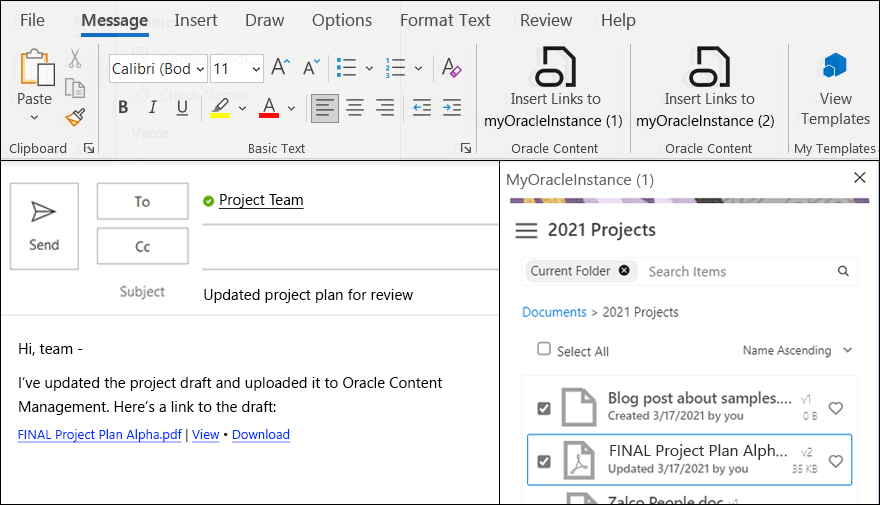
- The Desktop add-in for Microsoft Outlook has been replaced with an add-in that can be deployed on the Microsoft Exchange server by a service administrator. More...
- Users can still easily embed links to your Oracle Content files and folders into email messages or calendar appointments. More...
- To avoid confusion when using the new feature enabled by the service administrator, users should disable the previously installed Desktop add-in for Microsoft Outlook. More...
- Content Capture now allows creation of assets whose mandatory metadata is not yet ready but will be created later in Oracle Content Management. See Configure Asset or Business Repository Commit Driver Settings.
- Content Capture now maps reference fields to assets. See Configure Asset or Business Repository Commit Driver Settings.
- The Content Capture Client now includes a Refresh button to load new batch activities. See View Batch Activity Information.
- Custom translation connectors and Lingotek translation connectors can now return validation data, which displays on the asset or site translation job details page. More...
- Friendly management domains include several improvements:
- You now validate the friendly management domain change before it takes effect, and you can easily revert the change. More...
- Users are notified when a new friendly management domain is available or when a domain is removed.
- Custom sign-in now supports friendly management domains. More...
- There's new documentation describing how to set up a friendly management domain when you have a private instance. More...
- The REST API for Content Search now allows typed search to match text in the native files of digital assets. More...
- The Embed UI API now allows you to create a link to open the embed UI in a dialog. More...
- The Oracle Content Toolkit includes the following updates. More...
- There's a new
describe-background-jobcommand. - The
transfer-sitecommand now supports transferring published versions. - The
control-sitecommand now includes an option to expire a site.
- There's a new
22.7.1 — July 2022
- You can now access the Sauce Video application through the Oracle Content Management web client navigation menu. Sauce Video is the video creation platform for teams. It provides a fast, easy, and affordable way to create video anywhere and anytime. More...
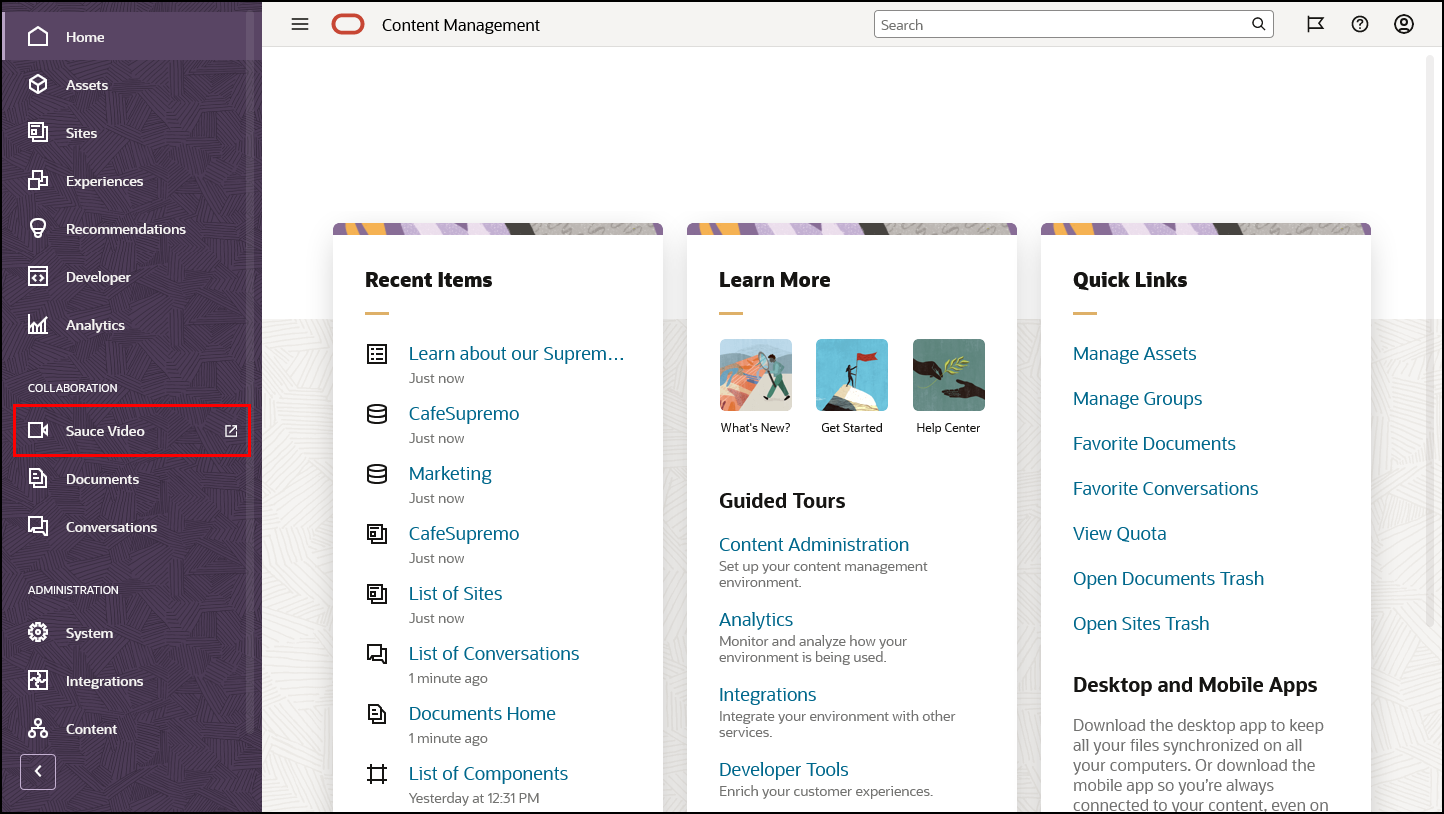
- The Oracle Content Toolkit includes the following updates. More...
- The Compilation Server now processes site pages in parallel, significantly reducing the compilation time, especially for large sites.
- You can now automatically run a set of Oracle Content Toolkit commands when a site is compiled during publishing by adding a
compile_site.shfile to the site. This allows you to perform actions such as post-processing compiled HTML, installing third party JavaScript libraries as required, or compiling site pages in parallel as needed. - When creating a component, you can now download the published version of the component (rather than just the base version).
- When creating a template from a site, you can now download the published versions of all site elements (rather than just the base version).
- The Embed UI API now includes the
assetViewer.views.defaultoption, allowing you to override a content type's default preview layout. More... - The documentation for the Embed UI API for Oracle Content Management has been moved out of Integrating and Extending Oracle Content Management, into its own guide. More...
22.6.2 — June 2022
- The Starter Edition now allows image editing. More...
- To accommodate large site publishing jobs, you can now skip the validation screen. More...
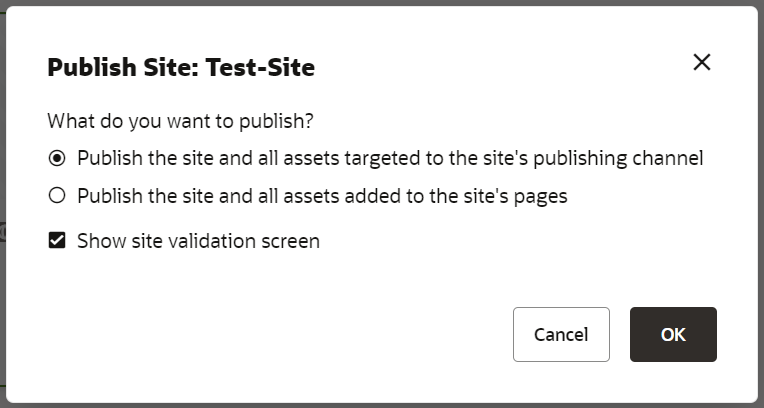
- The Integrations page user interface for enabling and disabling integrations has been improved. More...

- The Conversations page has been removed from the Administration: System area.
- The Oracle Content Toolkit includes the following updates. More...
- There is a new
delete-assetcommand. - You can now create a translation job editor.
- There is a new
22.6.1 — June 2022
- There's a new tutorial about deploying headless Oracle Content Management applications on Netlify. More...
- There are several site compilation improvements:
- The Oracle Content Toolkit
compile-templatecommand includes a new--localeGroup(-g) option to restrict which locales are included during site compilation. More... - You can now override compile options using a compile_config.json file and uploading it to the root folder of a site. More...
- The page compiler includes a new
afterPageCompileAPI which is called after all components have been added to the page and just before the page is written out.PageCompiler.prototype.afterPageCompile = function (args) {return Promise.resolve(‘<!-- post compile -->’ + args.layoutMarkup);};
- The Oracle Content Toolkit
- The Oracle Content Toolkit includes the following updates. More...
- There is a new
describe-sitecommand that lists the properties of a site. - The
control-sitecommand includes a new action toset-metadataon the site.
- There is a new
22.5.2 — May 2022
- You can now configure a repository to allow users to save assets with default or missing values in required fields. Those assets will be marked as not ready for use (review or publishing) until the required fields are completed. More...
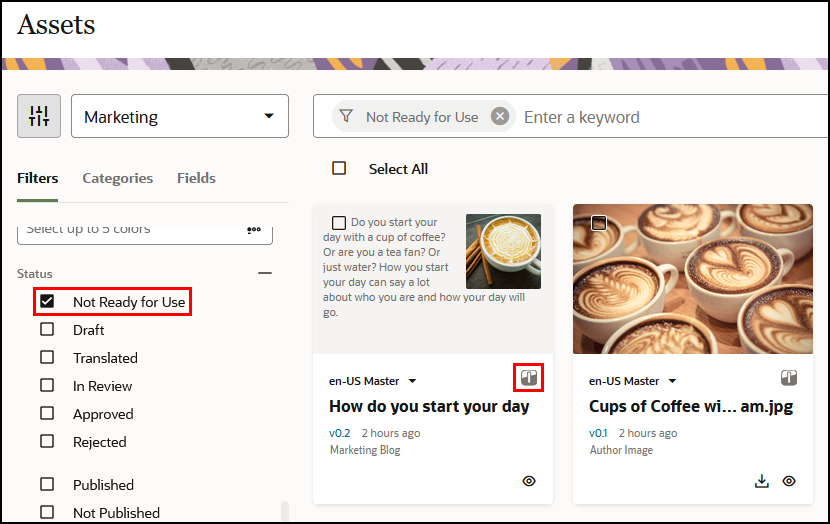
- You can now configure an asset type to use a site page as the default layout for viewing and previewing assets. More...
- The Oracle Content Toolkit includes the following updates. More...
- The
create-sitecommand now allows you to create a site from a template even if site governance shows the template as "inactive". - The
upload-templatecommand now includes an option to upload the template without a theme.
- The
- You can now resynchronize Oracle Content Management groups if the two internal database tables are ever out of sync. More...
- The Starter Edition now allows two taxonomies rather than just one. More...
- By default, users see a banner warning when they use an object that is available through public links or to external users. You can now hide this warning. More...
22.5.1 — May 2022
- There's a new Languages panel where you can view and manage all the translations for an asset. More...
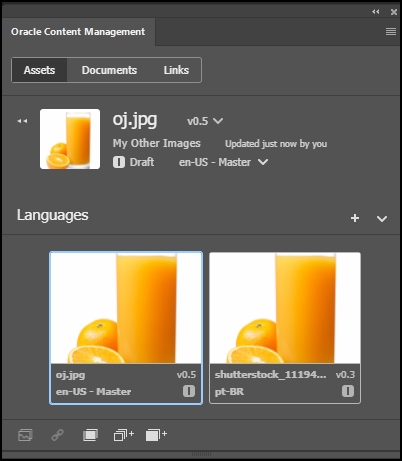
- You can now edit the name and description for digital assets. More...
- In addition to being able to view attributes for custom digital assets, you can now add and edit values. More...
- If allowed by the associated asset type, you can now add separate native media files for each language. More...
- You can now convert an asset from an out-of-the box digital asset type (Image, Video, Video Plus, or File) to a custom digital asset type. More...
- For an asset that was added from Documents, you can check if the linked Documents file has been updated, and then refresh the asset to the latest version. More...
- You can now control what to sync down to the subfolder level. Select specific subfolders to sync or remove some subfolders from sync. More...
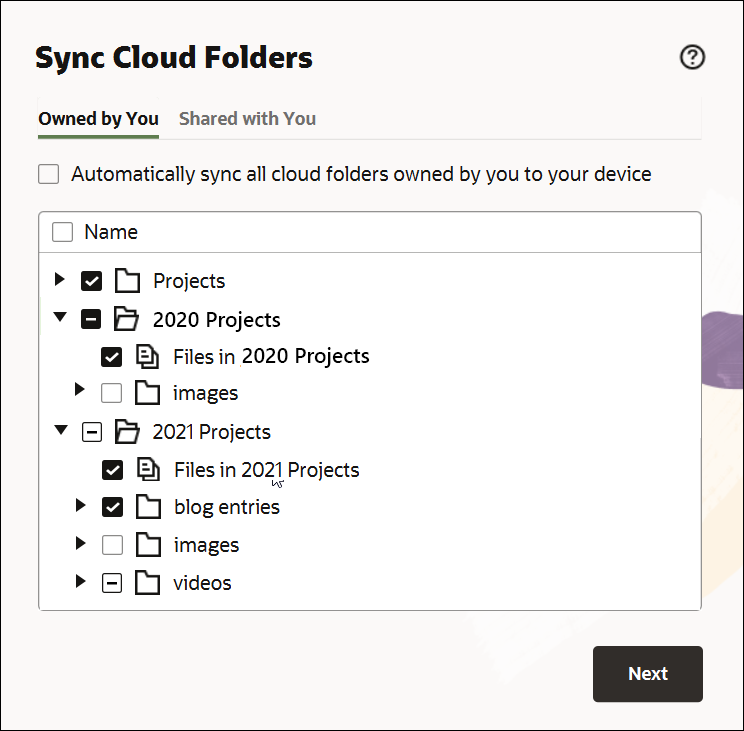
- The Site Assets tab on the desktop sync dialog is now hidden by default. If you're a site developer and have been syncing site assets such as templates, themes, and components, you can display the Site Assets tab by enabling it in your desktop preferences. More...
- Oracle Content Management now supports Microsoft Windows 11 (64-bit only) and Apple macOS Monterey (12). More...
- Notice: Microsoft Windows 32-bit versions are no longer supported. Only 64-bit Windows versions are now supported.
- You can now add custom properties for site pages in the form of name/value pairs. These properties are common across all pages in a site. Scripts and components on the pages can use these properties to tailor their behavior. More...
- When compiling a site, you can now include the default locale. More...
- You can now assign a weight to each asset type/data field pair. Items with value matches for the asset type/data field will have their relevance score boosted by the boost value multiplied by the specified field weight. More...
- The command line interface for Oracle Content Toolkit is now documented separately from Building Sites with Oracle Content Management. The new format makes it easier to find commands, command descriptions, and command groupings. More...
22.4.3 — April 2022
- Sauce Video is the video creation platform for teams. It provides a fast, easy, and affordable way to create video anywhere and anytime. Now, you can easily enable the Sauce Video Creation Platform during Oracle Content Management (OCM) instance creation, allowing you to use Sauce Video within your OCM environment, manage users centrally in Oracle Cloud
Infrastructure (OCI), and provide a common sign-in for both OCM and Sauce. More...
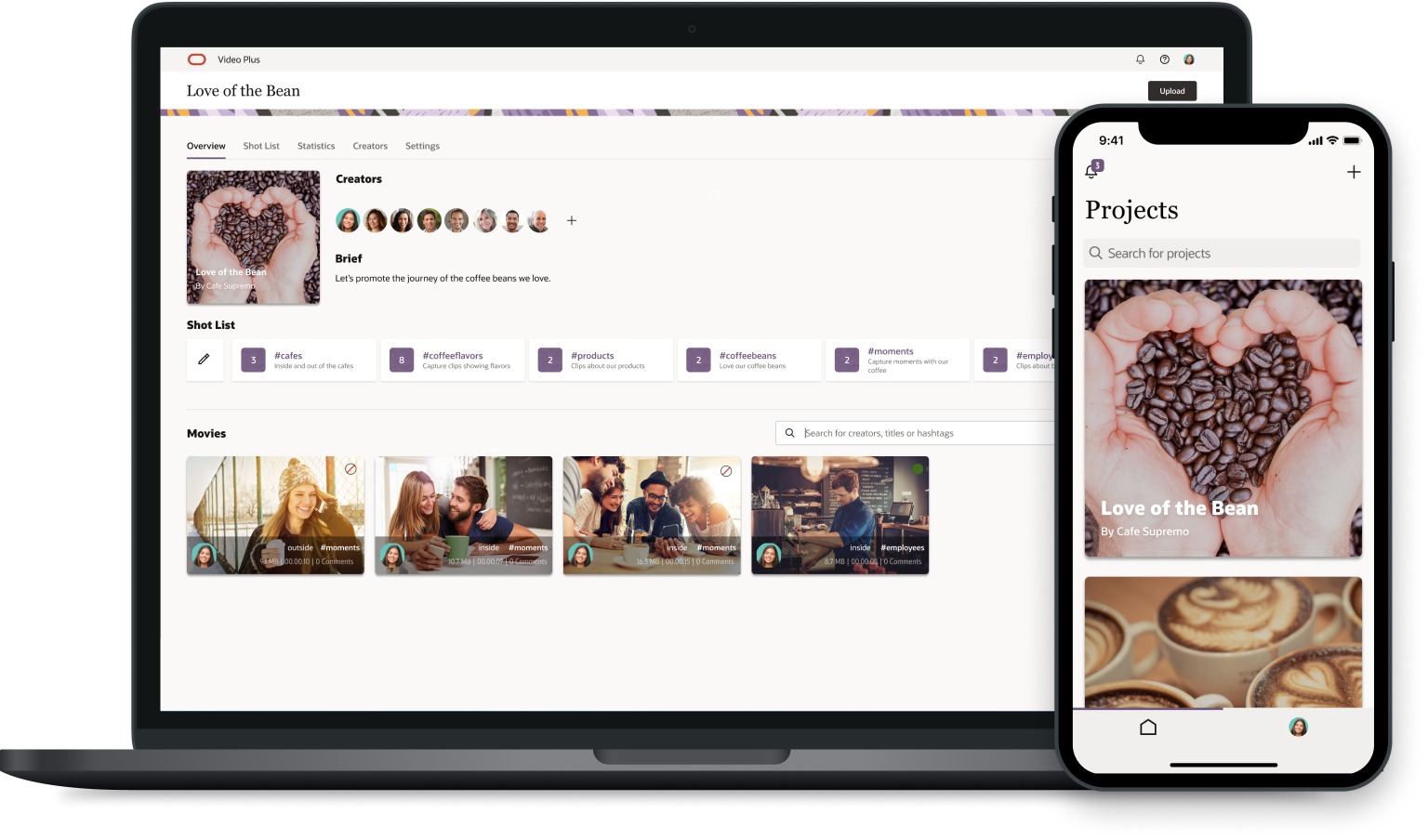
Embed API Security Enhancements
- The Embed V2 API now leverages the Content Security Policy
frame-ancestorsdirective for improved protection against clickjacking attacks. More... - While mostly a transparent change, it may require minor administration configuration adjustments. Content Security Policy
frame-ancestorsconfiguration supports only the wildcard character (*) as the first character in an allowed domain. For example, an existing whitelist configuration that includesx*.mydomain.comneeds to change to*.mydomain.com. - This change also impacts applink embedding. Unlike previous versions, a whitelist entry for the applink host is now required for applink embedding, just like standard embedding.
Asset Improvements
- Set default layouts for previewing content items and digital assets. More...
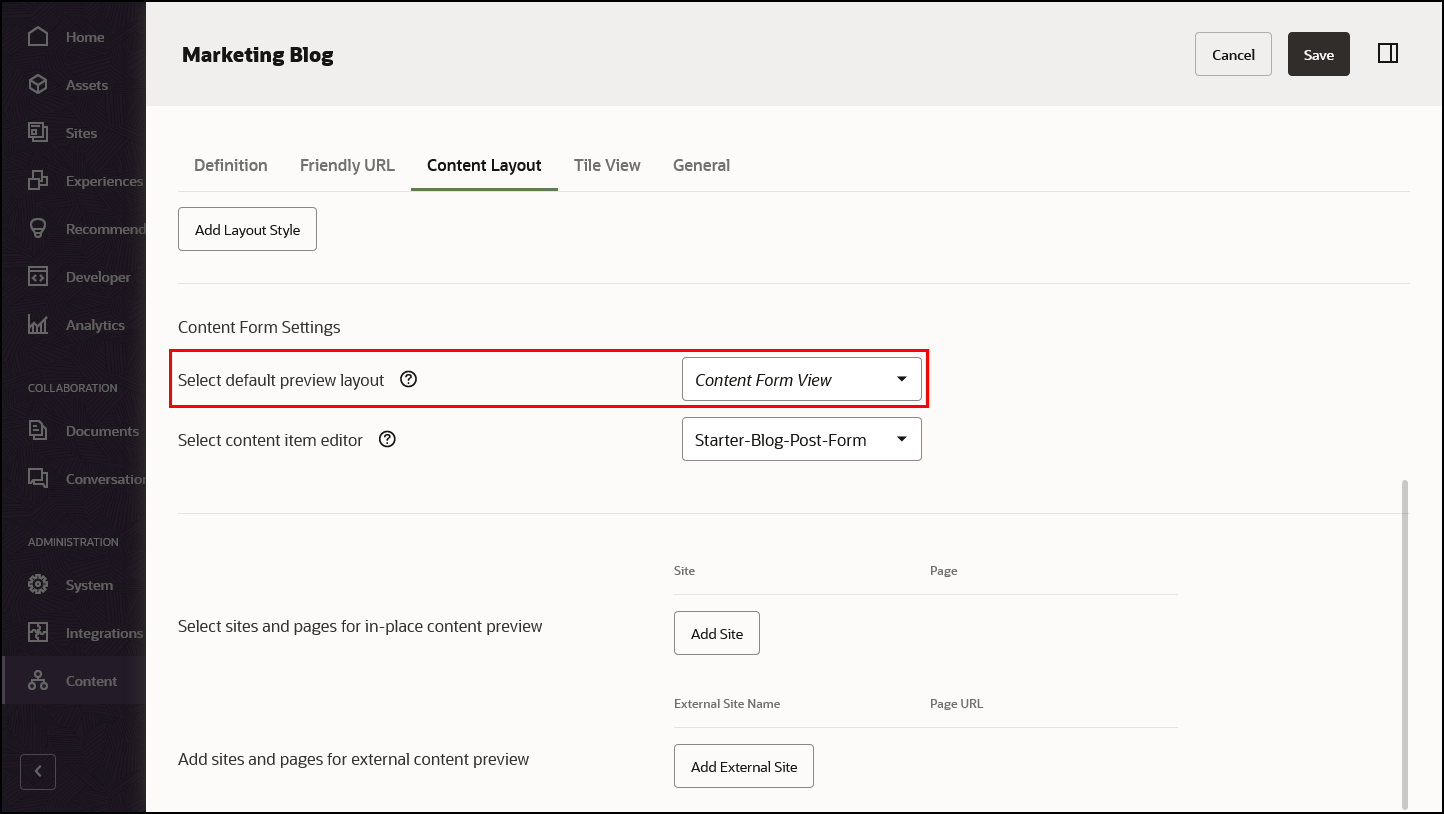
Content Capture Improvements
- You can now track the activity of a batch and share it with your support team for diagnostic purposes. More....
Developer Enhancements
- There are two new tutorials for headless samples: Integrate Consumption Analytics with Headless Samples in Oracle Content Management and Use Preview APIs in Headless Oracle Content Management Sites.
22.4.2 — April 2022
Asset Improvements
- New performance view on the Assets page displays performance data for assets to see the number of times an asset has been viewed or accessed by a user through a particular channel (like a site or portal). More...
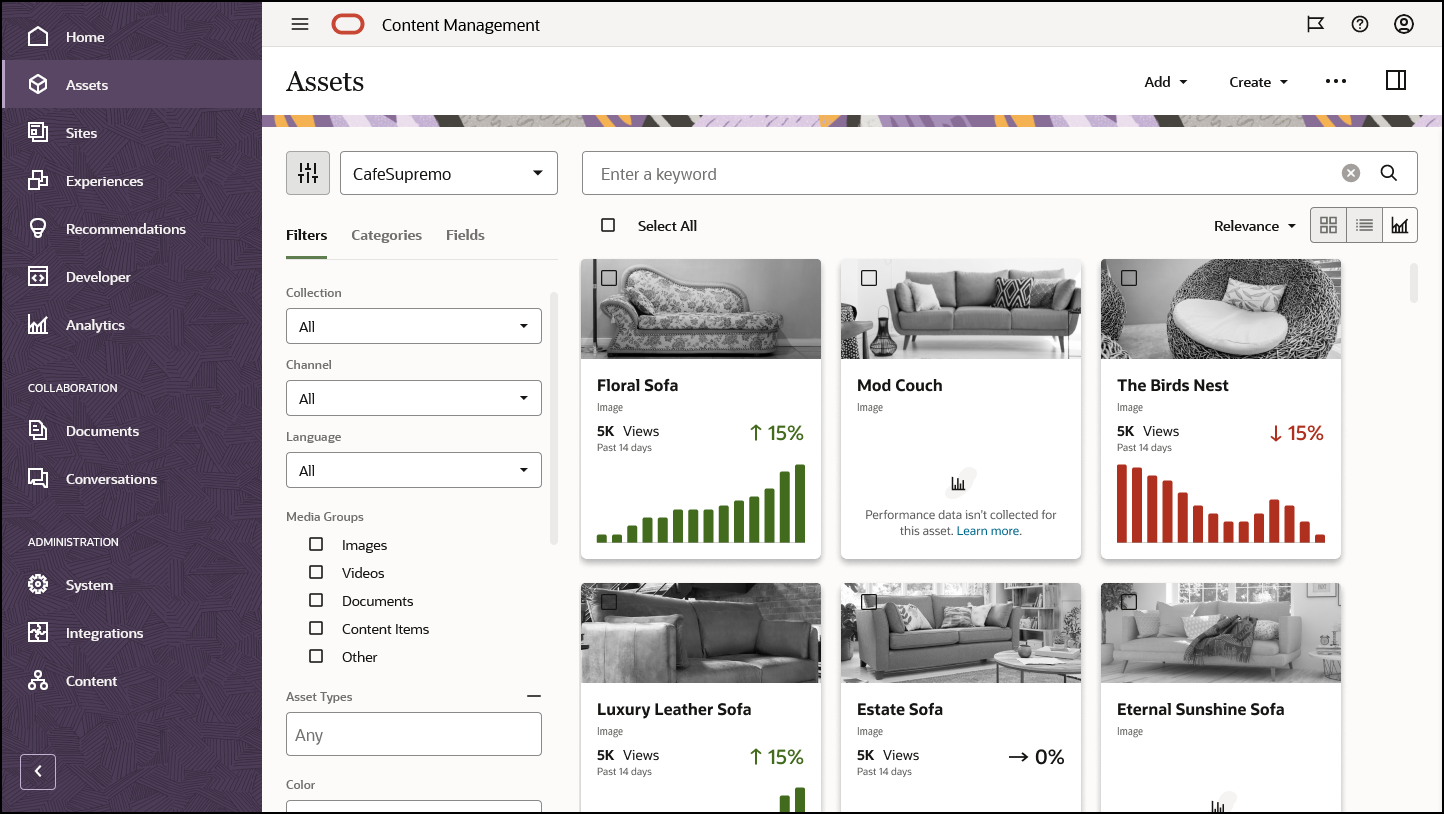
- Digital assets created by adding a media file from Documents can now be updated to the latest file version. More...
Developer Enhancements
- Site Builder now supports Preact and React components. More...
- The Oracle Content Toolkit includes the following updates. More...
- The command for publishing components now completes asynchronously through a background job on the server.
- There are additional validation checks to
download-content. - The toolkit now handles response data and ZIP files larger than 2GB.
- GraphQL now supports a
fileExtensionfield for digital asset references in an item. More...
Administrative Updates
- Kaltura Video Management - Video Plus is now available with all Oracle Content Management subscriptions. For this reason, enabling Video Plus has been moved from the System - Billing page to the Integrations - Applications page. More...
22.4.1 — April 2022
Asset Improvements
- You can now control the default layout for previewing assets in the web client. In the Asset Type editor, on the Content Layout tab, the Content Item Default layout now also applies to asset preview. More...
- Preview a content item during creation or editing without closing the content item editor. More...
- Any content workflow errors are now displayed in the Workflows panel. More...
- Search for assets based on referenced assets. More...
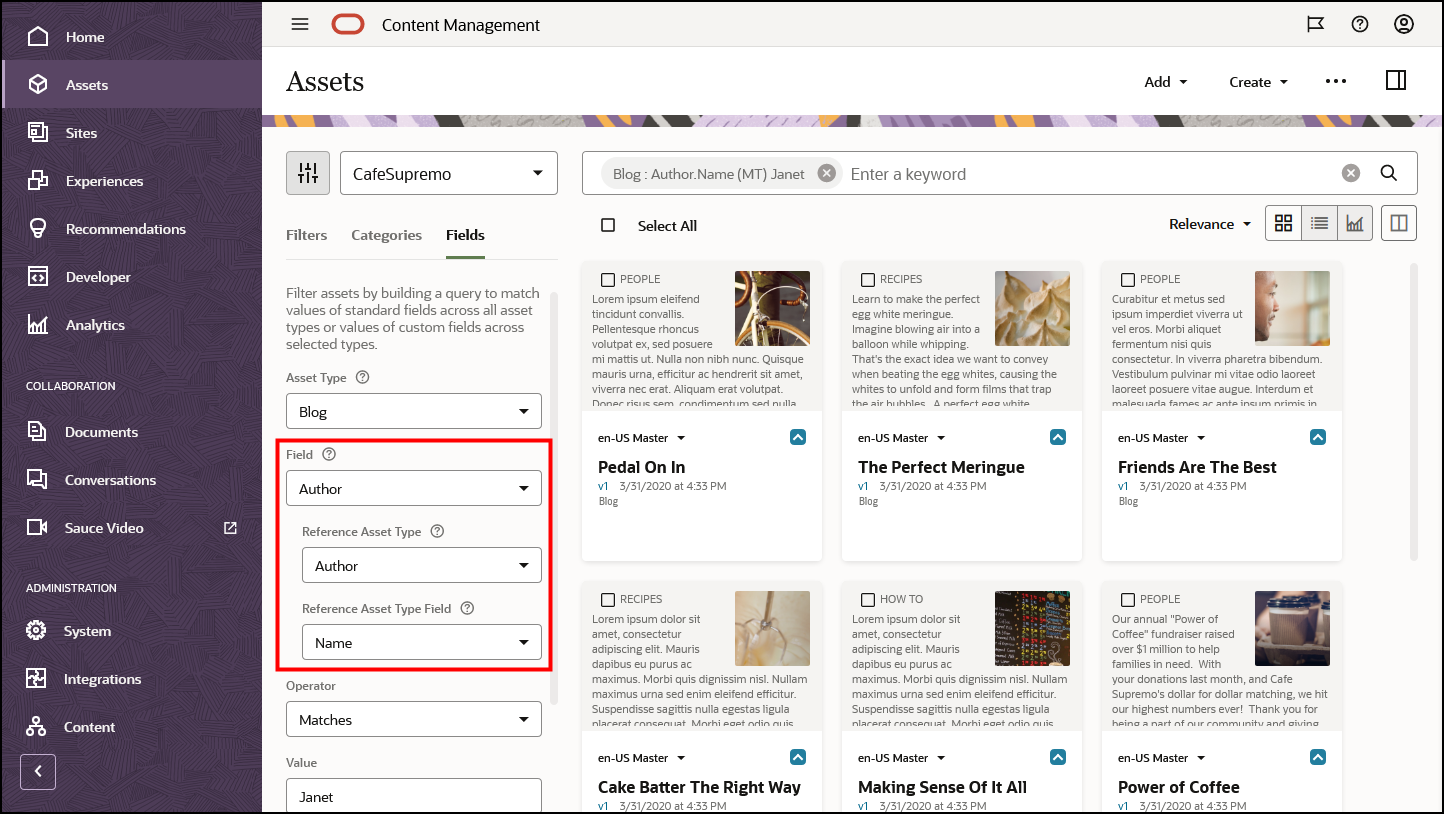
- Rename digital assets by editing the asset's attributes. More...
- Open an archived asset to preview it. More...
- On the Assets page, select an asset and open the sidebar panel to view analytics for the asset, the asset's associated conversation, or where the asset is used. More...
Documents Improvements
- Improved upload of large documents. More...
Developer Enhancements
- The Embed UI now supports toggling the sidebar panel. More...
- There are new headless samples for Flutter: blog sample, gallery sample, and minimal sample. More...
- The Integrating and Extending Oracle Content Management guide includes a new chapter about using the REST APIs for Content Management and Content Delivery to search for content, including ranking policies. More...
- The Oracle Content Toolkit now has enhanced sitemap generation options. More...
22.3.2 — March 2022
- Oracle Sales Accelerator is a new application built on top of Oracle Content Management, taking advantage of its extensive asset management capabilities and robust access control. It provides a one-stop shop for sales enablement content, allowing sales teams to readily access a wide variety of information and resources that make selling products and services easier. More...
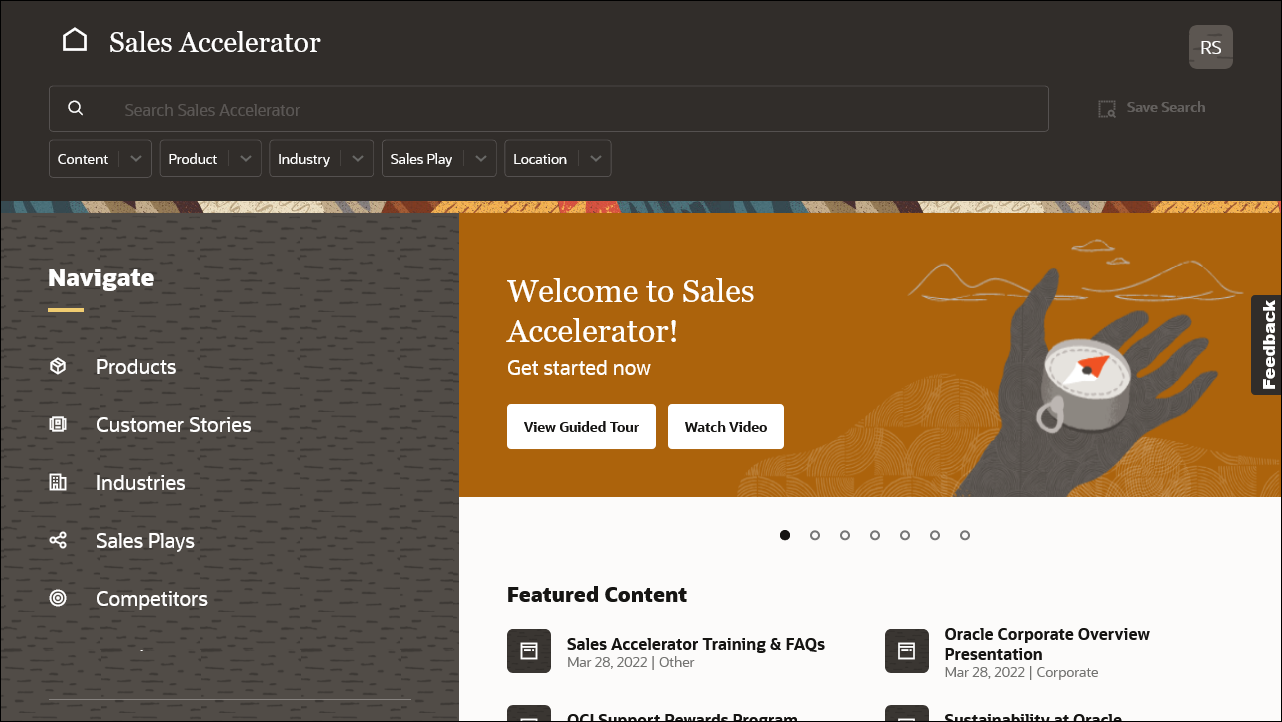
Custom Editorial Roles
- Create custom editorial roles to easily assign granular permission sets that you can apply to multiple repositories. More...

- If you need to change the permission set, you can edit the role and the changes will apply to all repositories that use the editorial role. More...
- Quickly make new editorial roles by copying an existing role and editing the permissions. More...
- After refining permissions for a repository, you can save the permission set as an editorial role. More...
Developer Enhancements
- The Lingotek translation connector now handles binary files. More...
- The custom content form SDK object includes new methods for editing media directly from the asset editor. The content form in the Blog Template sample has also been updated to include this functionality. More...
- The content form in the Embed UI now has two actions: Save for saving ongoing edits and Done for saving and closing the form. More...
Done is not enabled by default, so you should add the following options to your Embed UI configuration:
contentItemCreate.header.done: truecontentItemEditor.header.done: true
- GraphQL now supports additional search capabilities. More...
- Filtering items by category
- Searching across multiple types
- Sorting by user-defined fields up to two levels deep
- Searching in user-defined JSON fields and seeing those fields in item responses
- The Oracle Content Toolkit includes the following updates. More...
- The
validate-sitecommand now validates assets asynchronously through a background job on the server. - Support for custom editorial roles (described above).
- The
22.3.1 — March 2022
Switch to OCI IAM Identity Domains
- Oracle is in the process of updating Oracle Cloud Infrastructure (OCI) regions to switch from Identity Cloud Service (IDCS) to Identity and Access Management (IAM) identity domains. Depending on whether your region has been updated or not, you'll use different documentation to complete your deployment. More...
Documents Improvements
- After uploading a .zip file to Documents, you can now unzip the files to a folder, keeping the .zip file's folder structure. More...
Asset Improvements
- When localizing a custom digital asset, you can now select a native media file from Documents. More...
Content Capture Improvements
- When non-image files exist in a batch of documents, you now have an option to merge only the image files, ignoring the non-image files. More...
Developer Enhancements
- GraphQL supports querying unpublished content similar to Content Preview REST APIs. More...
- The Oracle Content Toolkit includes the following updates. More...
- Support for workflows in
listand newdescribe-workflowcommand. - Pagination support for queries.
- Support for ranking policies in
listandlist-assets.
- Support for workflows in
Administrative Enhancements
22.2.2 — February 2022
Knockout 3.5.1 Notice
- In the previous release of Oracle Content Management, the Knockout JS library in runtime sites was upgraded to version 3.5.1. The runtime of Oracle Content Management sites is responsible for rendering published pages. The code that renders pages in Site Builder has already been upgraded to Knockout 3.5.1. As this newer version of Knockout has a stricter syntax validation, you need to ensure your custom components will work with Knockout 3.5.1, and republish your existing sites if needed. For more information about this upgrade and the changes that may be required in your custom components, sign in to your Oracle Support account, and see Upgrade Knockout 3.4.2 to 3.5.1 in SitesCloudRuntime.
Archiving Assets
- You may have assets that aren't currently being used, but you're not ready to permanently delete them yet. You can archive those assets so they don't appear on the Assets page or when users select asset references. More...
- You can easily manage archived assets on the repository's Archived Assets page, where they can be viewed, downloaded, restored, or permanently deleted. More...
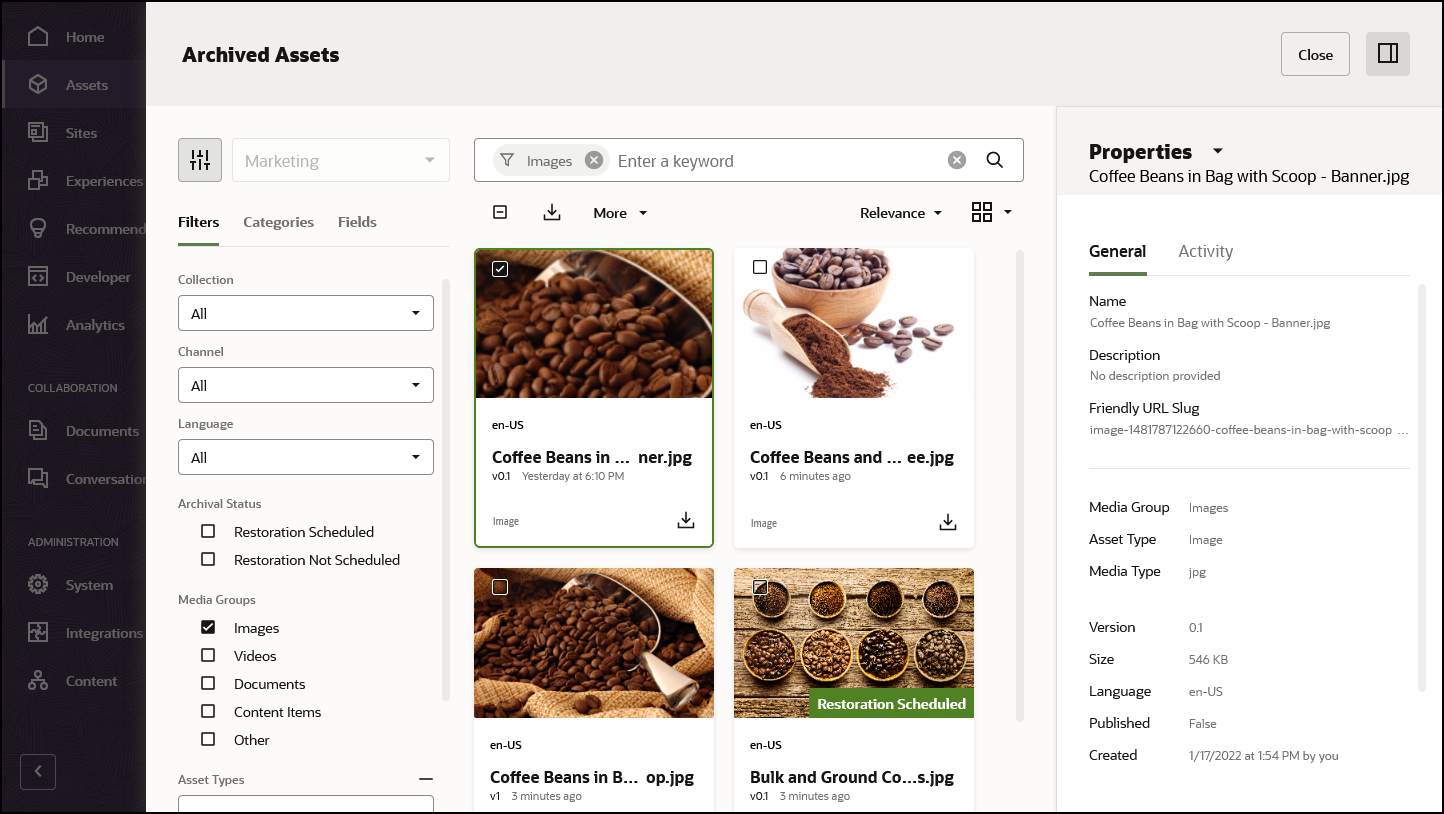
- Archived assets are billed at 1/200th the cost of standard assets. For example, if you have 2,000 archived assets, that would be billed as 10 standard assets. You can quickly see how many archived assets you have in your instance on the Billing page in the administration area. More...
- Archived asset totals are also shown on the Repositories page in the analytics area. More...
Repository Improvements
- Business repositories now include language support, which allows you to mark an asset as being in a particular language when you create or edit it. More...
Content Capture Improvements
- With XML transformation jobs you can now select specific XML elements from a document to transform into attachments or additional documents that contain those XML elements and their children. More...
- The File Import Agent now supports authentication using the OAuth/bearer token from the user’s Oracle Content Management web client session. That means short-term, temporary projects no longer require you to create an IDCS application. More...
Developer Enhancements
- The Oracle Content Toolkit includes the following updates. More...
- Support for
execute-put. - The content form SDK and sample now support separate localized media files for digital assets.
- Support for excluding a theme for standard sites in
transfer-site. - Support for OAUTH token in
.cec_propertiesconfig file. - When using the Oracle Content Toolkit, the selected component type and selected template on a local test server are retained.
- Support for
Administrative Enhancements
- System administrators can enable or disable email notifications about taxonomy events, such as promotion, publication, removal from the repository, or deletion. More...
22.2.1 — February 2022
Knockout 3.5.1 Notice
- In this release of Oracle Content Management, the Knockout JS library in runtime sites has been upgraded to version 3.5.1. The runtime of Oracle Content Management sites is responsible for rendering published pages. The code that renders pages in Site Builder has already been upgraded to Knockout 3.5.1. As this newer version of Knockout has a stricter syntax validation, you need to ensure your custom components will work with Knockout 3.5.1, and republish your existing sites if needed. For more information about this upgrade and the changes that may be required in your custom components, sign in to your Oracle Support account, and see Upgrade Knockout 3.4.2 to 3.5.1 in SitesCloudRuntime.
Asset Improvements
- Scheduled publishing jobs now show which version of an asset will be published, and you can easily update included assets to the latest version. More...
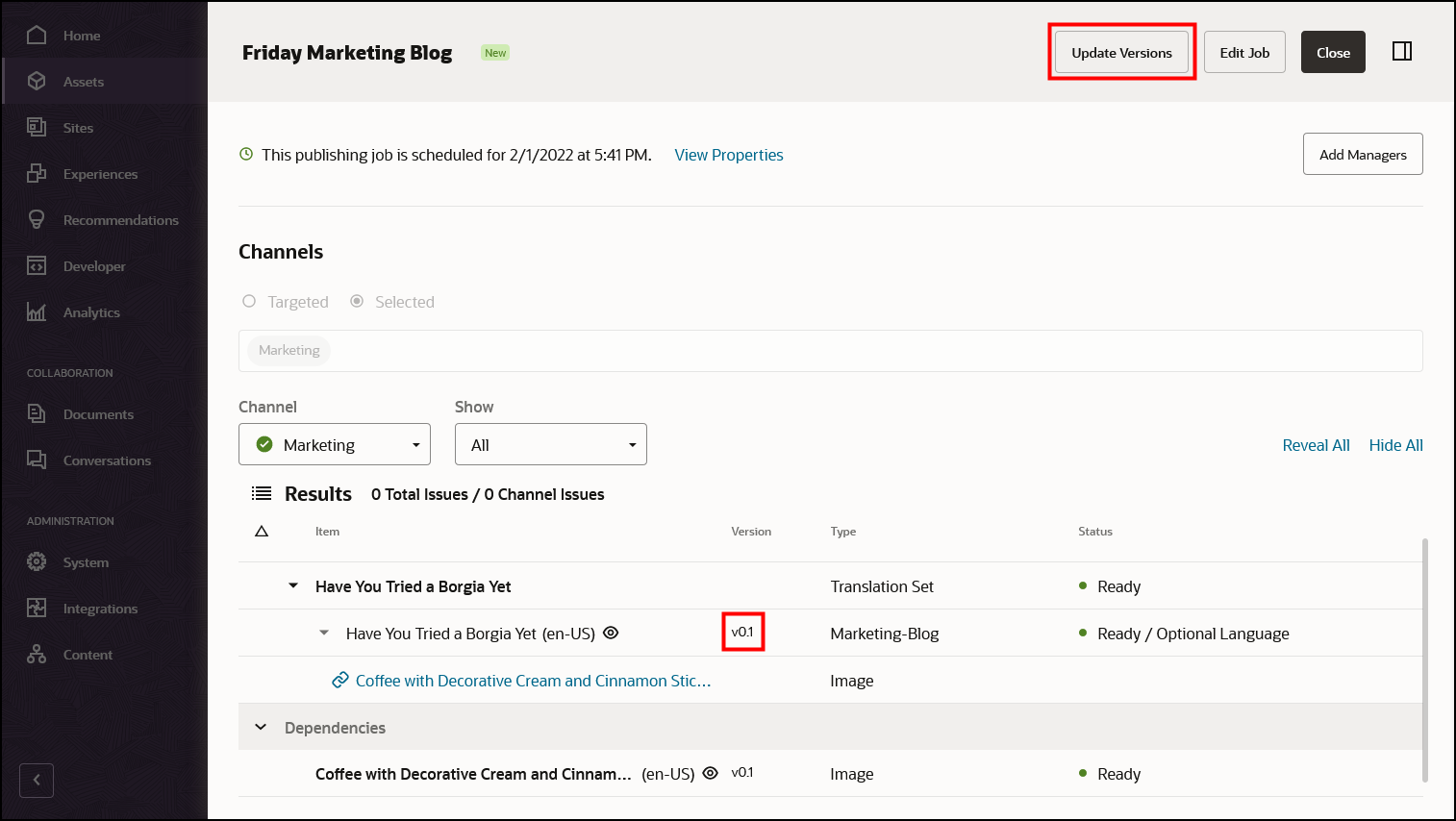
- Digital assets can now include localized media files. More...
- You can now search and filter images based on EXIF metadata. More...
- Asset types no longer have the contributor role. You control users ability to use an asset type through repository roles and granular permissions. More...
Developer Enhancements
- You can now copy and paste component groups in Site Builder. More...
- The Oracle Content Toolkit includes the following updates. More...
- Support for
execute-delete. - Support for copying resource types.
- Support for showing properties of resource types.
- Support for
Administrative Enhancements
- You can now receive push notifications about scheduled publishing jobs. More...
22.1.2 — January 2022
Knockout 3.5.1 Notice
- In the February 2022 release of Oracle Content Management, the Knockout JS library in runtime sites will be upgraded to version 3.5.1. The runtime of Oracle Content Management sites is responsible for rendering published pages. The code that renders pages in Site Builder has already been upgraded to Knockout 3.5.1. As this newer version of Knockout has a stricter syntax validation, you need to ensure your custom components will work with Knockout 3.5.1, and republish your existing sites if needed. For more information about this upgrade and the changes that may be required in your custom components, sign in to your Oracle Support account, and see Upgrade Knockout 3.4.2 to 3.5.1 in SitesCloudRuntime.
Asset and Repository Improvements
- You can now remove assets from a pending scheduled publishing job. More...
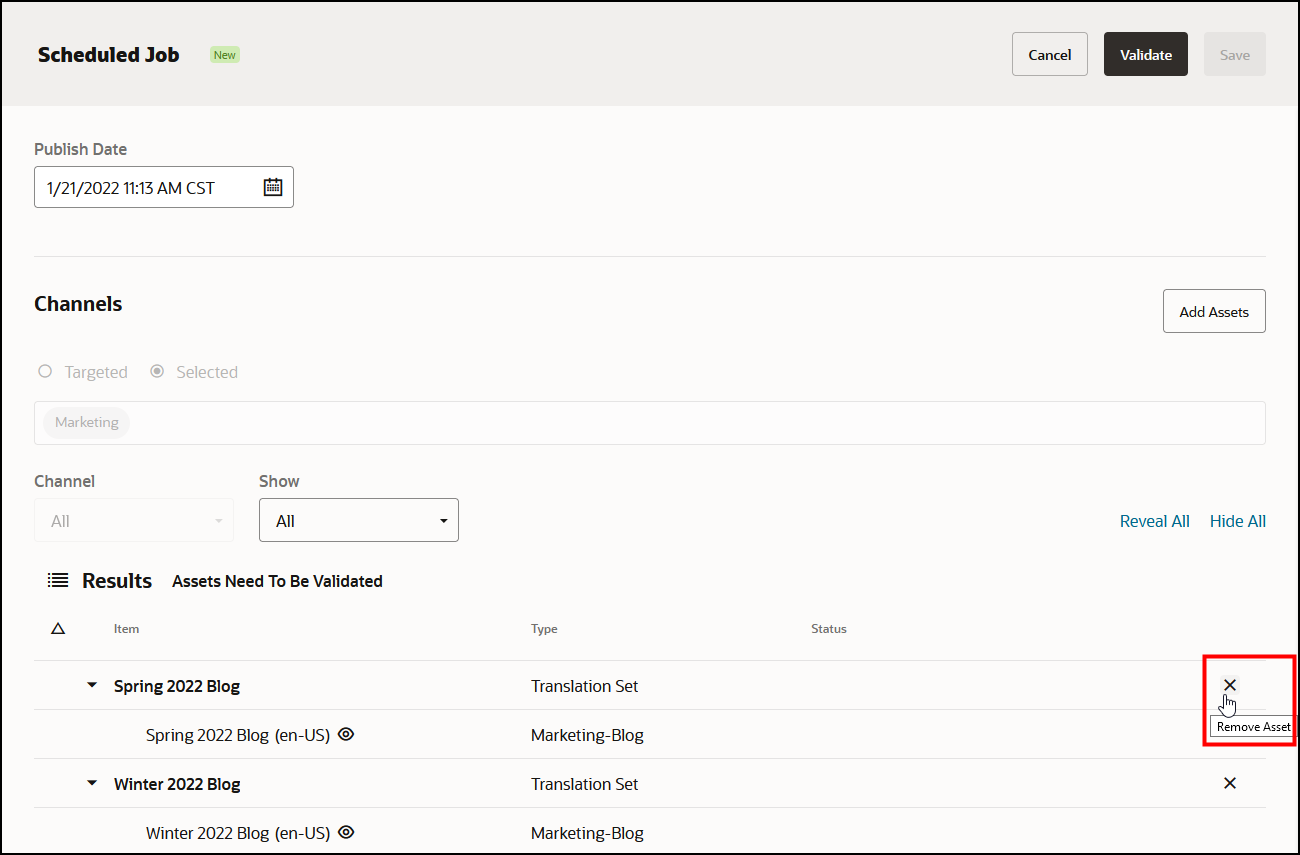
- You can now add up to 10 taxonomy category rules (increased from 5) in the granular permissions for a repository. More...
- The Adobe Creative Cloud extension includes new right-click menu options to add a translation to an asset and to make an asset translatable or non-translatable. More...
Developer Enhancements
- You can set the display language for the embeddable user interface. More...
- GraphQL provides the ability to sort assets by user-defined fields, up to two levels deep. More...
- GraphQL provides the ability to see JSON user-defined fields in search results. More...
Administrative Enhancements
- Use your own Oracle Infinity instance for consumption analytics (rather than the default instance provided with Oracle Content Management). More...
- When you define a friendly management URL, users will still be able to access the web client using the original URL, but they will be redirected to the friendly URL and will see that URL in their browser address bar. More...
22.1.1 — January 2022
Knockout 3.5.1 Notice
- In the February 2022 release of Oracle Content Management, the Knockout JS library in runtime sites will be upgraded to version 3.5.1. The runtime of Oracle Content Management sites is responsible for rendering published pages. The code that renders pages in Site Builder has already been upgraded to Knockout 3.5.1. As this newer version of Knockout has a stricter syntax validation, you need to ensure your custom components will work with Knockout 3.5.1, and republish your existing sites if needed. For more information about this upgrade and the changes that may be required in your custom components, sign in to your Oracle Support account, and see Upgrade Knockout 3.4.2 to 3.5.1 in SitesCloudRuntime.
Ranking Policy Improvements
- You can now view the channels to which a ranking policy has been assigned. More...
- The data field selector in the ranking policy method user interface has been improved: standard fields are separated from custom fields and data fields show the field type. More...
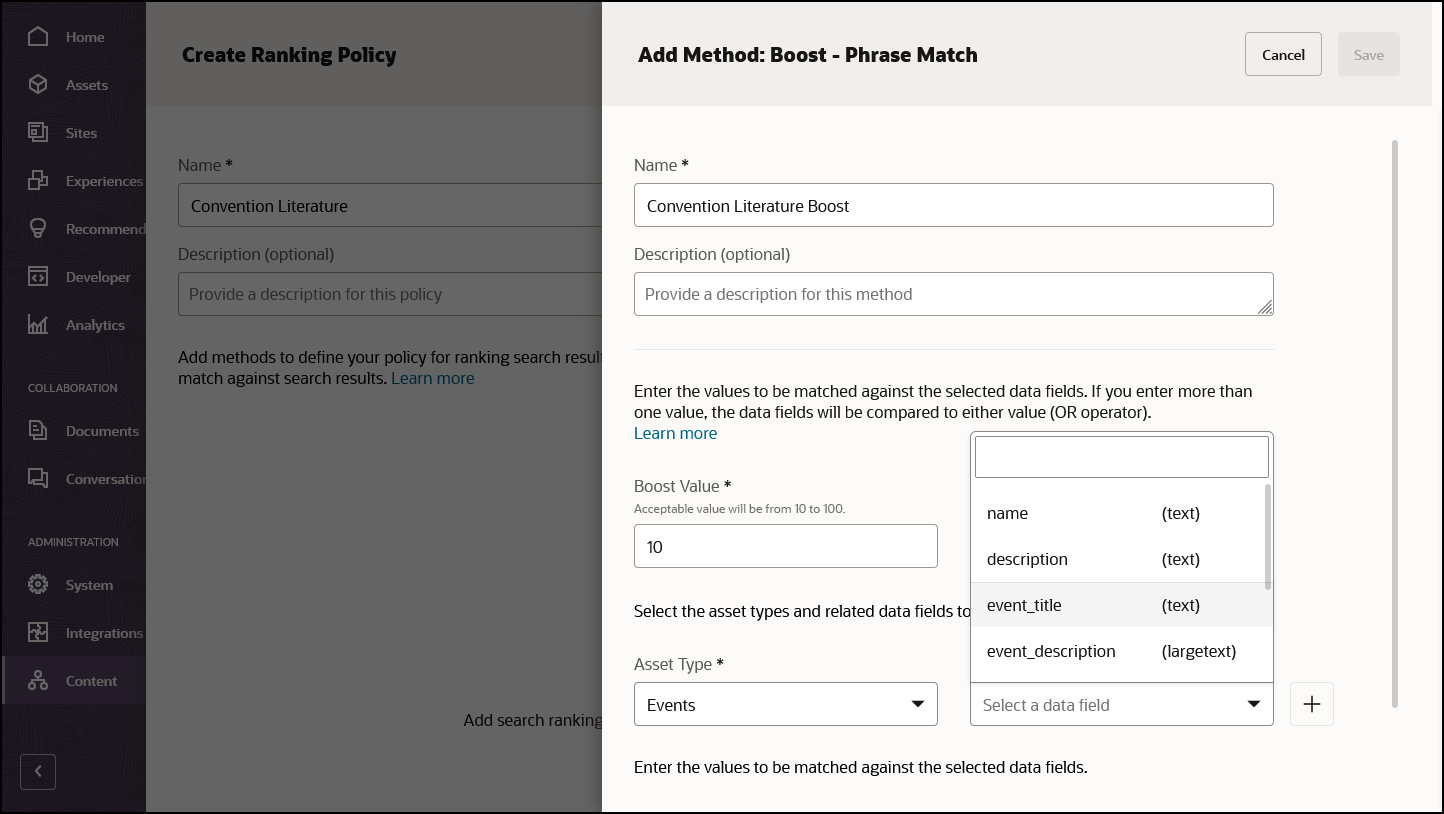
Asset Improvements
- You can now preview assets included in a scheduled publishing job. More...
- Edit language assets directly from the Manage Languages dialog. More...
Adobe Creative Cloud Extension Improvements
- You can now select an asset type and language when adding an item to an asset repository. More...
- You can now set the language and whether the asset is translatable when uploading a new asset. More...
- The language of an asset is shown in the Assets view and in the asset's properties. More...
- You can now filter images created with a camera by camera data such as where the picture was taken or by whom. More...
Developer Improvements
- Add user data to an external service call by the Oracle Content Management proxy. More...
- GraphQL provides the ability to query for assets based on specific types. More...
- There are new headless samples for Angular: blog sample, gallery sample, and minimal sample. More...
- View custom user attributes for an authenticated user viewing a secured site via query parameters with the /me REST endpoint. More...
21.12.2 — December 2021
Knockout 3.5.1 Notice
- In the February 2022 release of Oracle Content Management, the Knockout JS library in runtime sites will be upgraded to version 3.5.1. The runtime of Oracle Content Management sites is responsible for rendering published pages. The code that renders pages in Site Builder has already been upgraded to Knockout 3.5.1. As this newer version of Knockout has a stricter syntax validation, you need to ensure your custom components will work with Knockout 3.5.1, and republish your existing sites if needed. For more information about this upgrade and the changes that may be required in your custom components, sign in to your Oracle Support account, and see Upgrade Knockout 3.4.2 to 3.5.1 in SitesCloudRuntime.
Consumption Analytics Notice
- After enabling consumption analytics at the tenant-level, you must also enable consumption analytics at the site-level on any sites for which you want to collect usage metrics. More...
External Users
- External users may be people outside of your organization that can collaborate on objects to which they're given access, but they can't be assigned the manager role. This safely limits their ability to create and remove content, similar to how visitors can sign in and use specified secure sites. This allows you to work with outside contributors such as translators and partners. More...
- Control whether external users are allowed to be invited to your service. More...
- Add external users just as you would add any other user, and assign them the External User application role. More...
- Your users can share files, folders, conversations, and sites with external users as they would for any other user. More...
- Prevent external users from being added to particular folders or sites by disabling external user access and membership for that object. More...
Ranking Policy Improvements
- A new 'decay - date' method decreases the relevance score of items that are returned by the search request. An item's relevance score decreases as the selected asset type's date value gets further away from the origin date and offset. The rate of decrease is defined by the specified decay rate and scale. More...
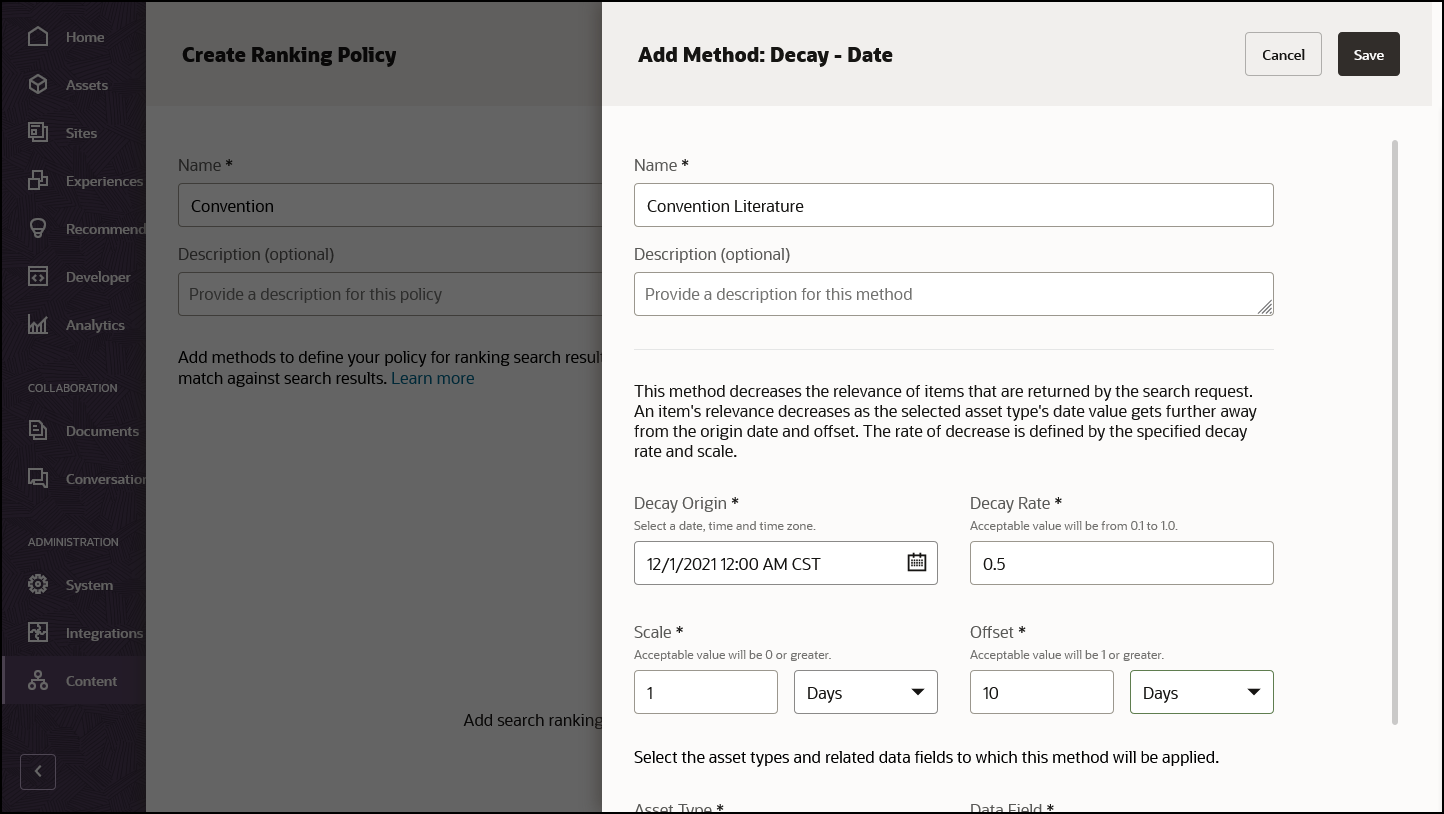
- A new 'decay - numeric' method decreases the relevance score of items that are returned by the search request. An item's relevance score decreases as the selected asset type's numeric value gets further away from the origin and offset. The rate of decrease is defined by the specified decay rate and scale. More...
Content Capture Improvements
- Content Capture can now interact with WebCenter Forms Recognition (WFR) via the WFR agent. The WFR agent works with Capture to retrieve queued documents and pushes those documents to WFR by performing a WFR import job. More...
Additional Improvements
- You can now resubmit failed translation jobs. More...
- WebP files can now be previewed in Oracle Content Management. More...
- Maximum video file size is now controlled by the Maximum upload and sync file size setting on the General settings page in the system administration area. More...
- Write your own Infinity tag on pages in headless sites. More...
21.12.1 — December 2021
Knockout 3.5.1 Notice
- In the February 2022 release of Oracle Content Management, the Knockout JS library in runtime sites will be upgraded to version 3.5.1. The runtime of Oracle Content Management sites is responsible for rendering published pages. The code that renders pages in Site Builder has already been upgraded to Knockout 3.5.1. As this newer version of Knockout has a stricter syntax validation, you need to ensure your custom components will work with Knockout 3.5.1, and republish your existing sites if needed. For more information about this upgrade and the changes that may be required in your custom components, sign in to your Oracle Support account, and see Upgrade Knockout 3.4.2 to 3.5.1 in SitesCloudRuntime.
Ranking Policy Improvements
- A new 'pin - equals' method sets the topmost relevance to items returned by the search request only if the data field values in the selected asset types exactly match the specified values (EQ operator is applied). More...

- A new 'pin - phrase match' method sets the topmost relevance to items returned by the search request only if the phrase values in the selected asset types match the specified values (MT operator is applied). More...
Usability Improvements
- Searching for public groups has been improved. More...
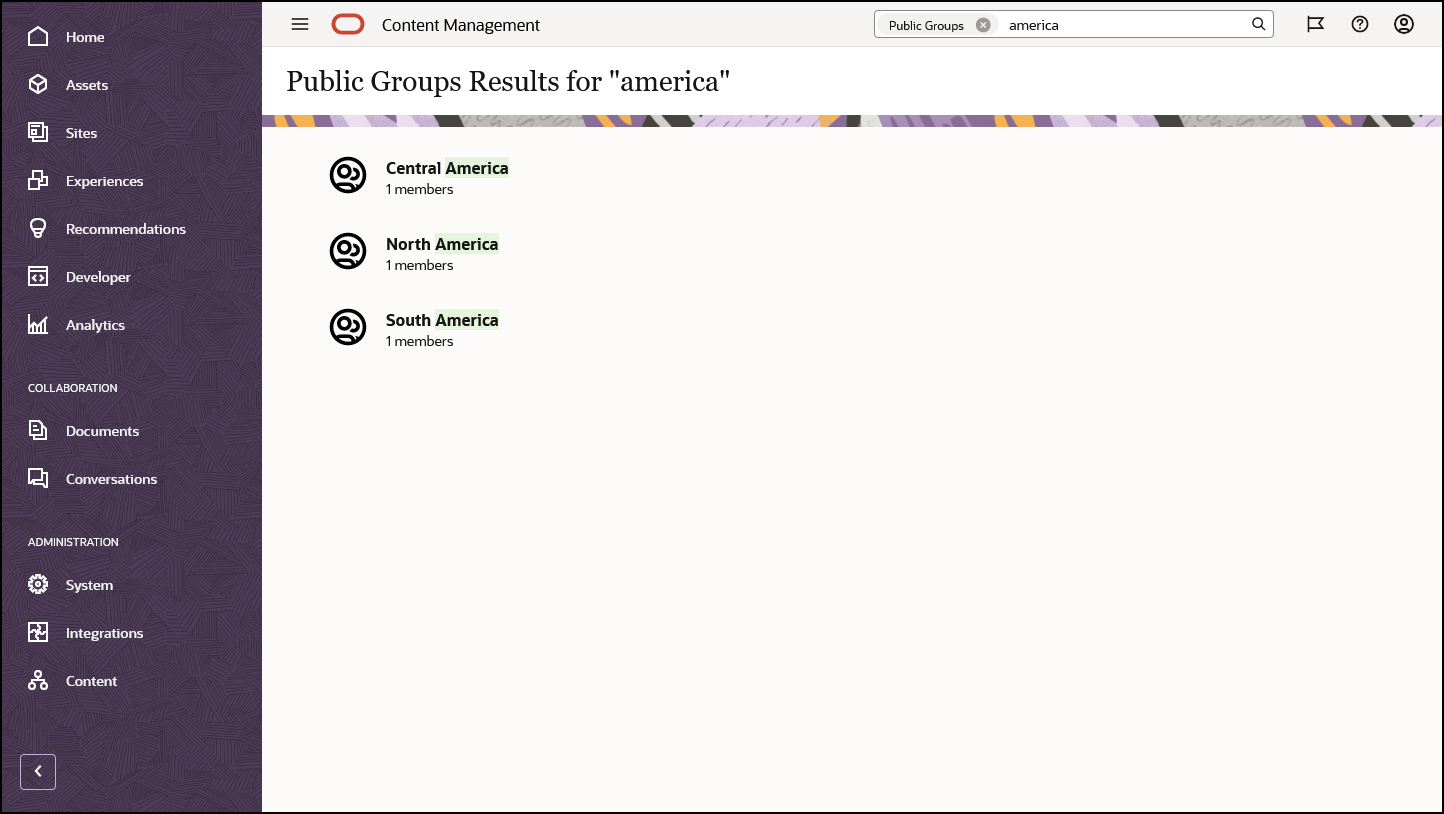
Developer Improvements
- Oracle Content Management now uses JavaScript Modules for loading JavaScript libraries. All seeded component starter templates and included examples were updated to use JS Modules, but you can still use RequireJS for backward compatibility or to support legacy browsers. More...
- New headless samples, tutorials, and videos for technologies like Gatsby, Next.js, React, Vue, Oracle Digital Assistant, and Oracle Visual Builder. More...
21.11.2 — November 2021
Knockout 3.5.1 Notice
- In the February 2022 release of Oracle Content Management, the Knockout JS library in runtime sites will be upgraded to version 3.5.1. The runtime of Oracle Content Management sites is responsible for rendering published pages. The code that renders pages in Site Builder has already been upgraded to Knockout 3.5.1. As this newer version of Knockout has a stricter syntax validation, you need to ensure your custom components will work with Knockout 3.5.1, and republish your existing sites if needed. For more information about this upgrade and the changes that may be required in your custom components, sign in to your Oracle Support account, and see Upgrade Knockout 3.4.2 to 3.5.1 in SitesCloudRuntime.
Ranking by Relevance in Assets Search
- Oracle Content Management calculates the default relevance score for items matching a search query in the REST API for Content Delivery. However, you can now control how the relevance score is calculated by defining and using custom ranking policies. More...
- Use boost methods to increase the relevance score of items returned by search requests only if the values in the selected asset types match the values you configure in the method. More...
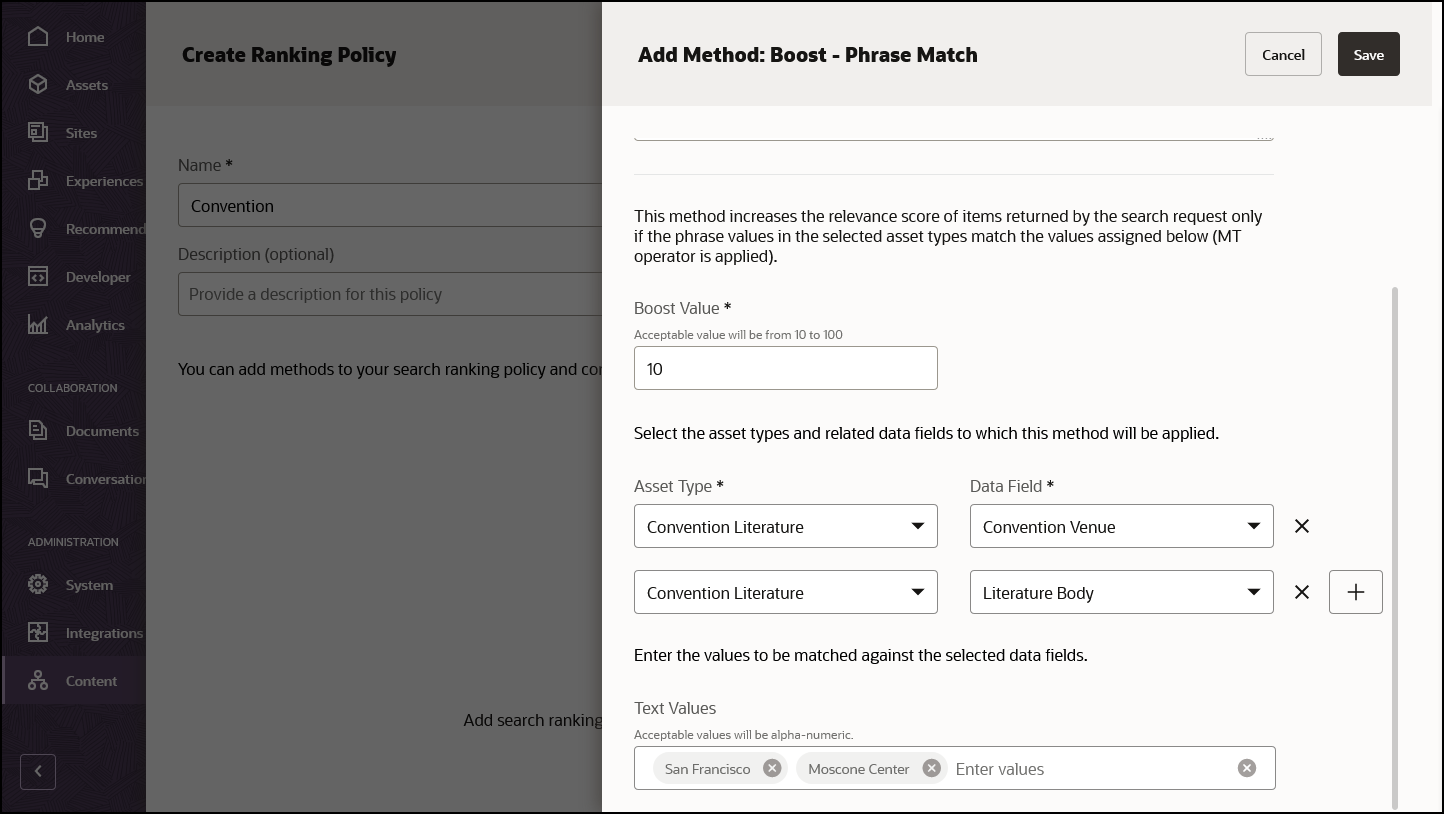
- Assign a custom ranking policy as the global default. More...
- Override the global ranking policy default for a specific publishing channel by assigning a channel default. More...
- Use a ranking policy in a search request in the REST API for Content Delivery. More...
Multilingual Digital Assets
- Assets of custom digital asset types are now translatable by default, just like content items. More...
- Use the Languages view to manage all the languages for a digital asset in one place. More...
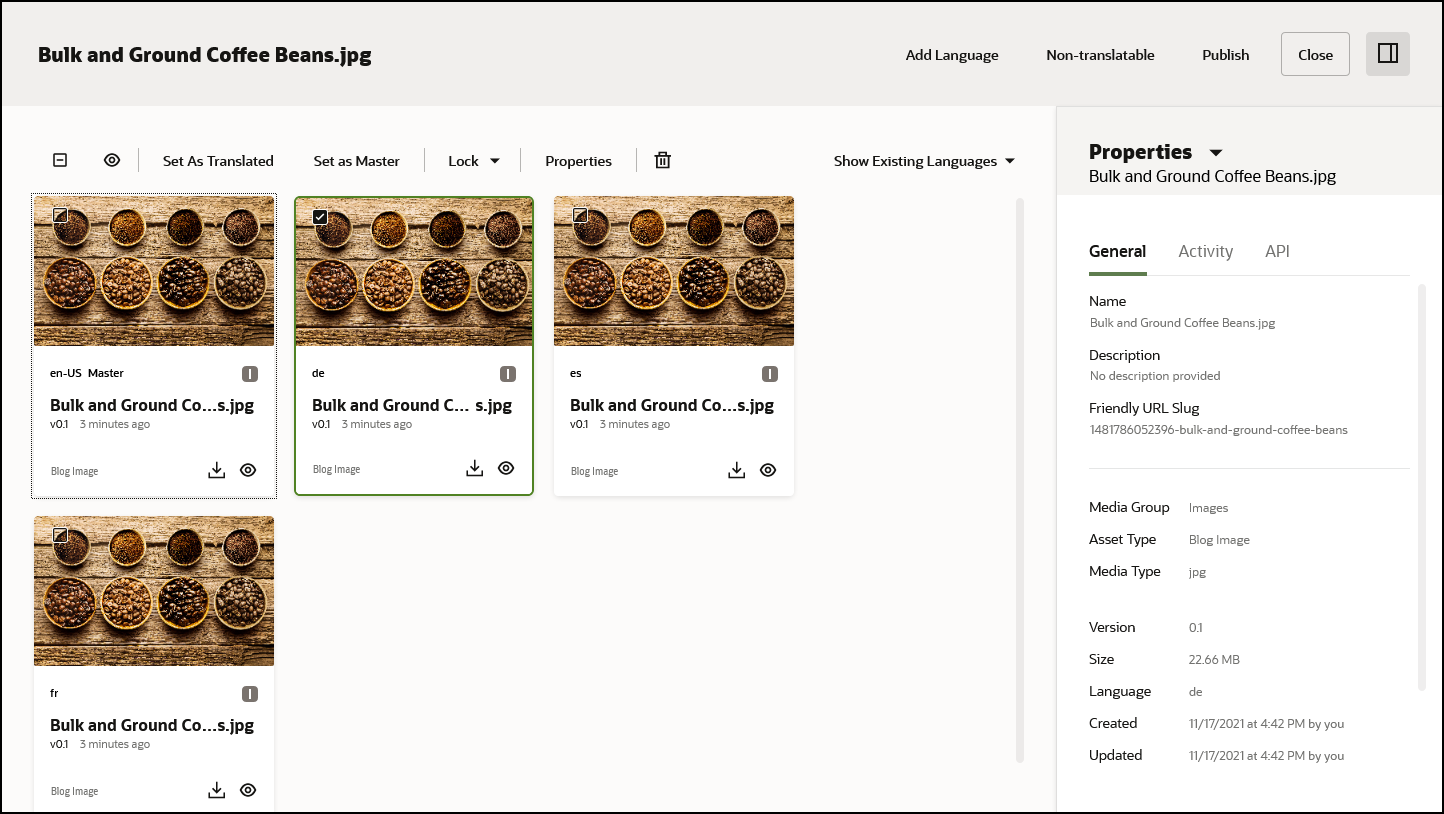
- Add a language to a digital asset translation set and localize the asset's attributes as needed, or export asset source files and submit them for translation by an external vendor. More...
- Use multilingual digital assets in Site Builder, or publish them for delivery subject to the localization policy assigned to the channel. For example, if French is a required language for a channel, but the digital asset has not been translated to French, then publishing is blocked.. More...
Desktop App Improvements
- The desktop app has a new look and a new sync activity dialog. More...
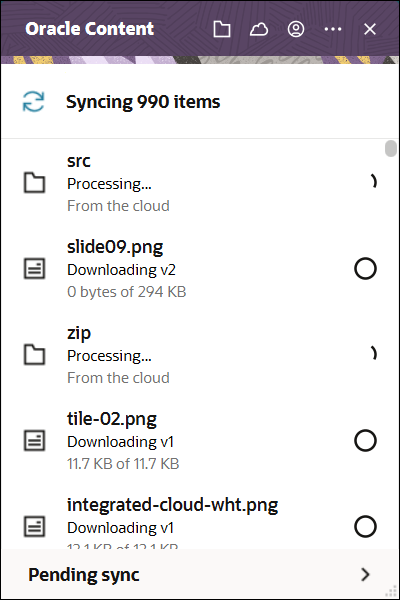
- Quickly manage sync activity and monitor sync status.
- Easily open file locations in your local account or in the cloud.
- Manage accounts, notifications, and other preferences.
Content Capture Improvements
- Conditional Assignment Processor provides a basic conditional logic that gives you the flexibility to manipulate metadata field values and change document profiles. More...
Usability Improvements
- Download files directly from search results. More...
- Search for translation jobs by job name or custom attributes. More...
REST API for Content Preview Improvements
- Preview categorization information on assets as if assets and taxonomies are already published. More...
- Preview search results as if all items matching your search query are already published.
21.11.1 — November 2021
Asset Improvements
- For digital assets created by a camera, view the camera data embedded by the device when the image was created. More...
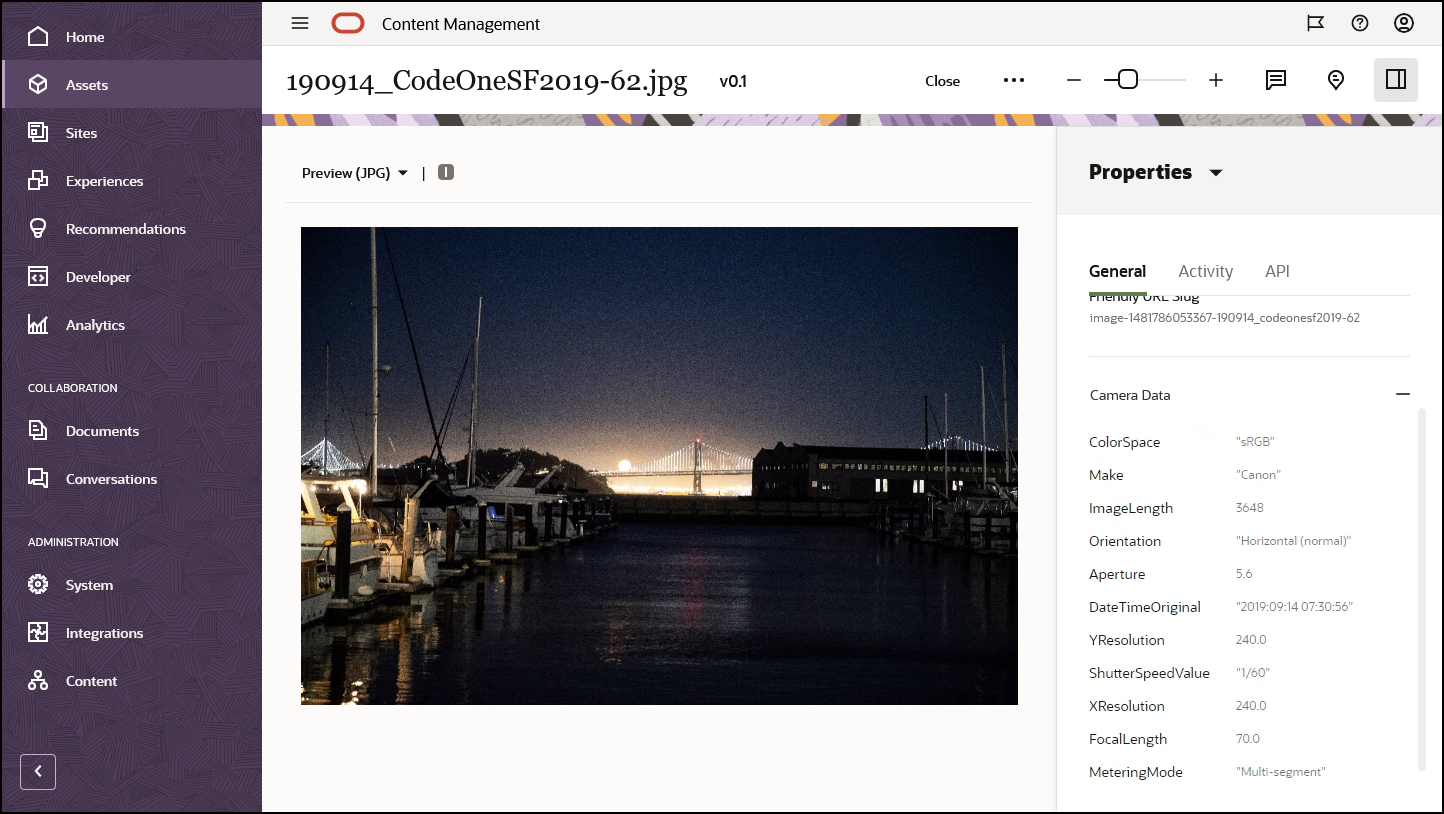
- Create display names for asset types, making it easier for users to find the asset type they need. The display name is used in the user interface, for example, on the Assets page. More...
Site Improvements
- In Site Builder, you can create new assets when configuring Content Item, Image, Gallery, Gallery Grid, or Video components on a site page. More...
21.10.2 — October 2021
Consumption Analytics
- Collect and track loads, views, downloads, and plays of assets across sites built with Site Builder and headless experiences. More...
- Consumption analytics appear in the Analytics sidebar panel when viewing an asset. More...
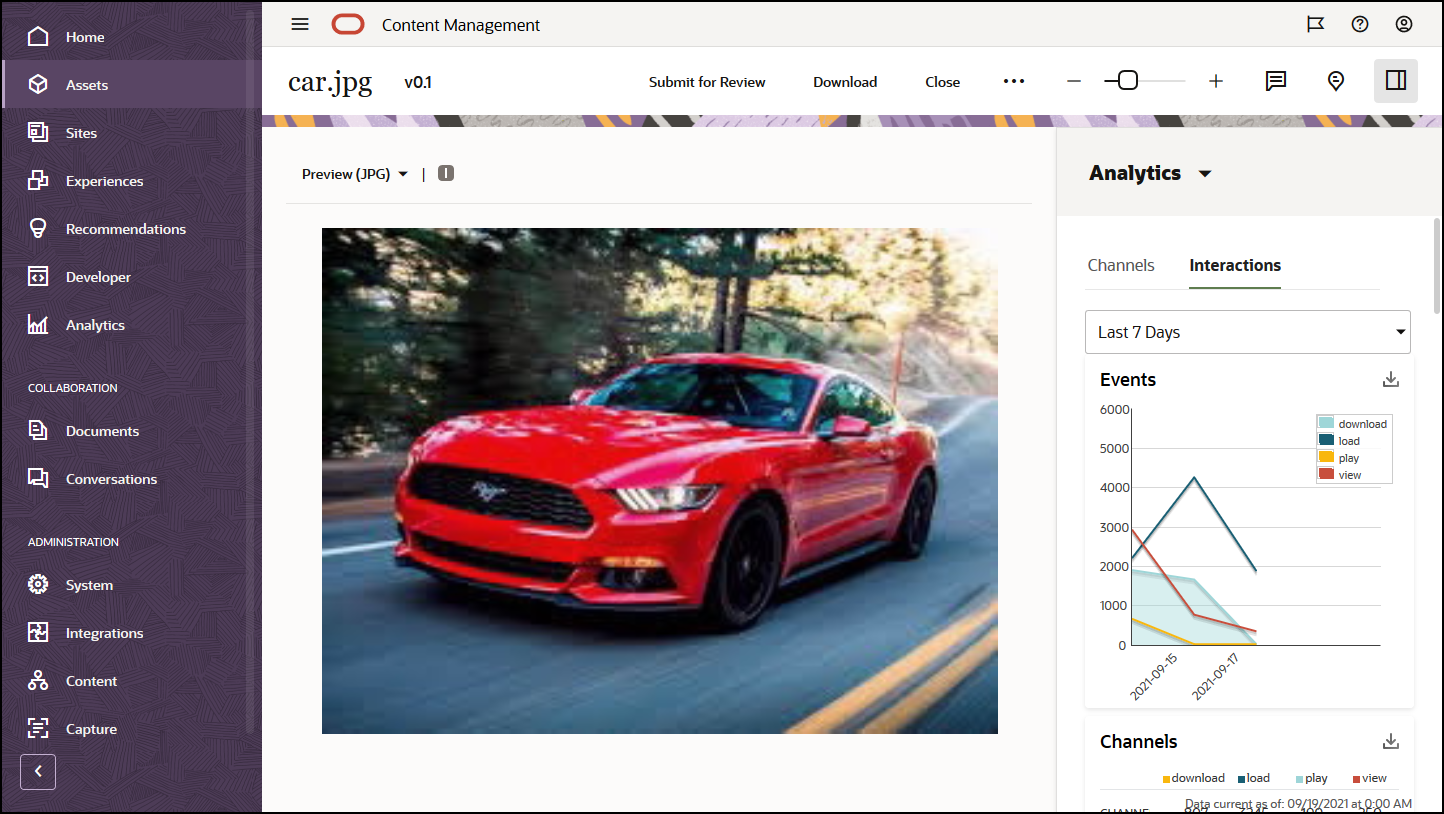
- Control collection of consumption analytics at the tenant or site level. More...
- Add asset tracking to custom layouts and components. More...
Asset Improvements
- View the history of membership and permission changes for a repository. More...
- Change the language assigned to a content item. More...
Site Improvements
- Create an enterprise site with the option to duplicate, override, or update assets in the repository. More...
- Save and publish an edited content item directly from Site Builder. More...
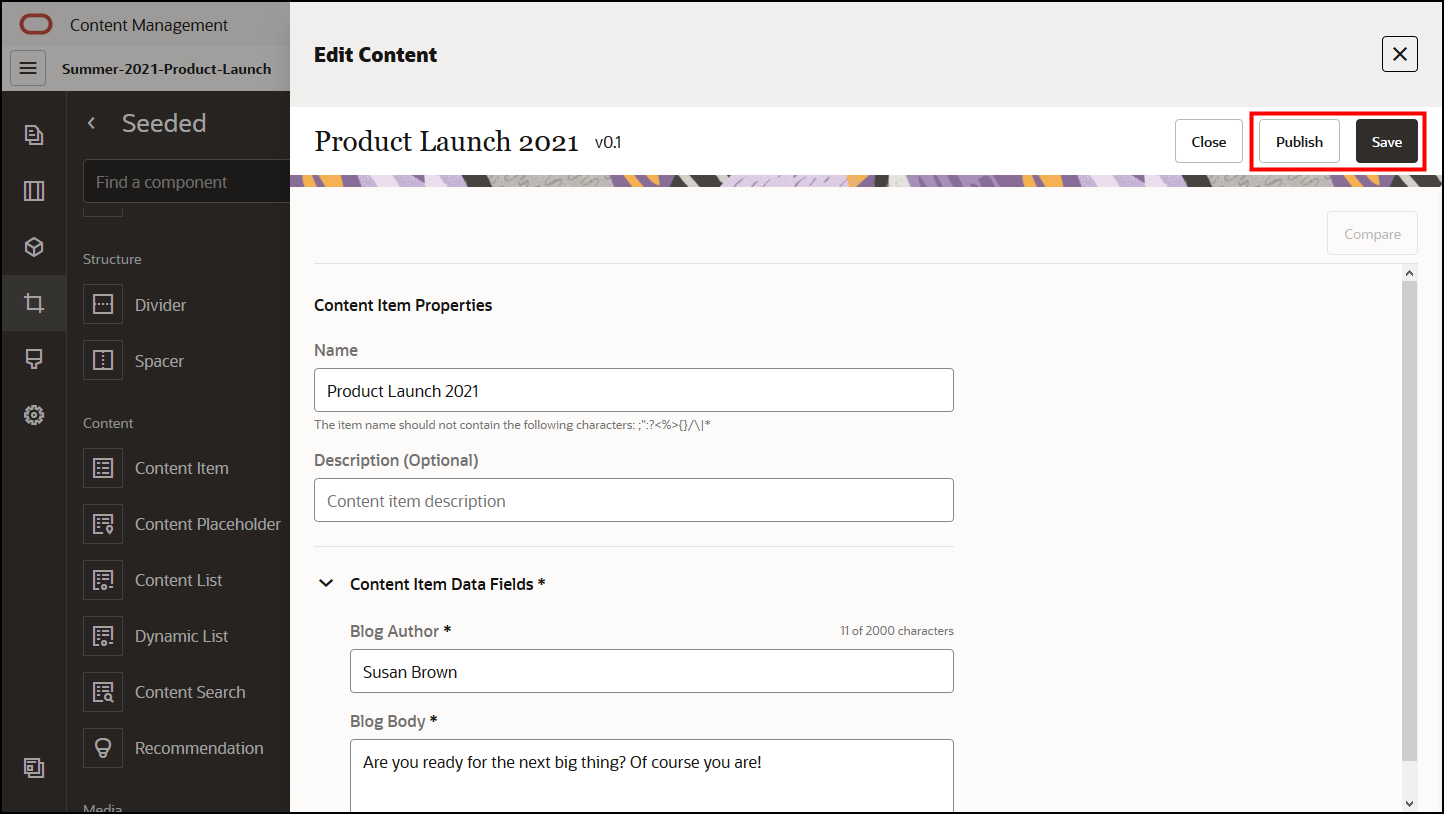
Developer Enhancements
- The new REST API for Content Preview provides access to preview the latest versions of assets, including content items, digital assets, and their renditions. More...
- Improved WebCenter content connector. More...
- GraphQL provides the ability to query for assets based on standard fields, and list published taxonomies and their categories. More...
Other Improvements
- Set up instance-level vanity domains to access sites created with Oracle Content Management. More...
- New search feature in Sites, Developer, and Content areas to make it easier to find and select objects.
- Content Capture functionality to import email messages and attachments now supports another OAuth 2.0 authentication protocol called Authorization Code Flow Grant. This option is available with the Microsoft email exchange service type as Authorization code flow plus Exchange Online Keys.. More...
21.10.1 — October 2021
Asset Improvements
- Set Name and Description fields in content types to "Do not translate" or "Inherit from master". More...

- Publish directly from the content item editor. More...
- New "Created by me" filter on Translation Jobs page. More...
- Asset attributes are now displayed in the Adobe Creative Cloud extension. More...
Developer Enhancements
21.9.1 — September 2021
Asset Improvements
- Search for images by color. Colors are automatically detected on new images (images created in Oracle Content Management version 21.9.1 or later) when smart content is enabled in the repository. More...
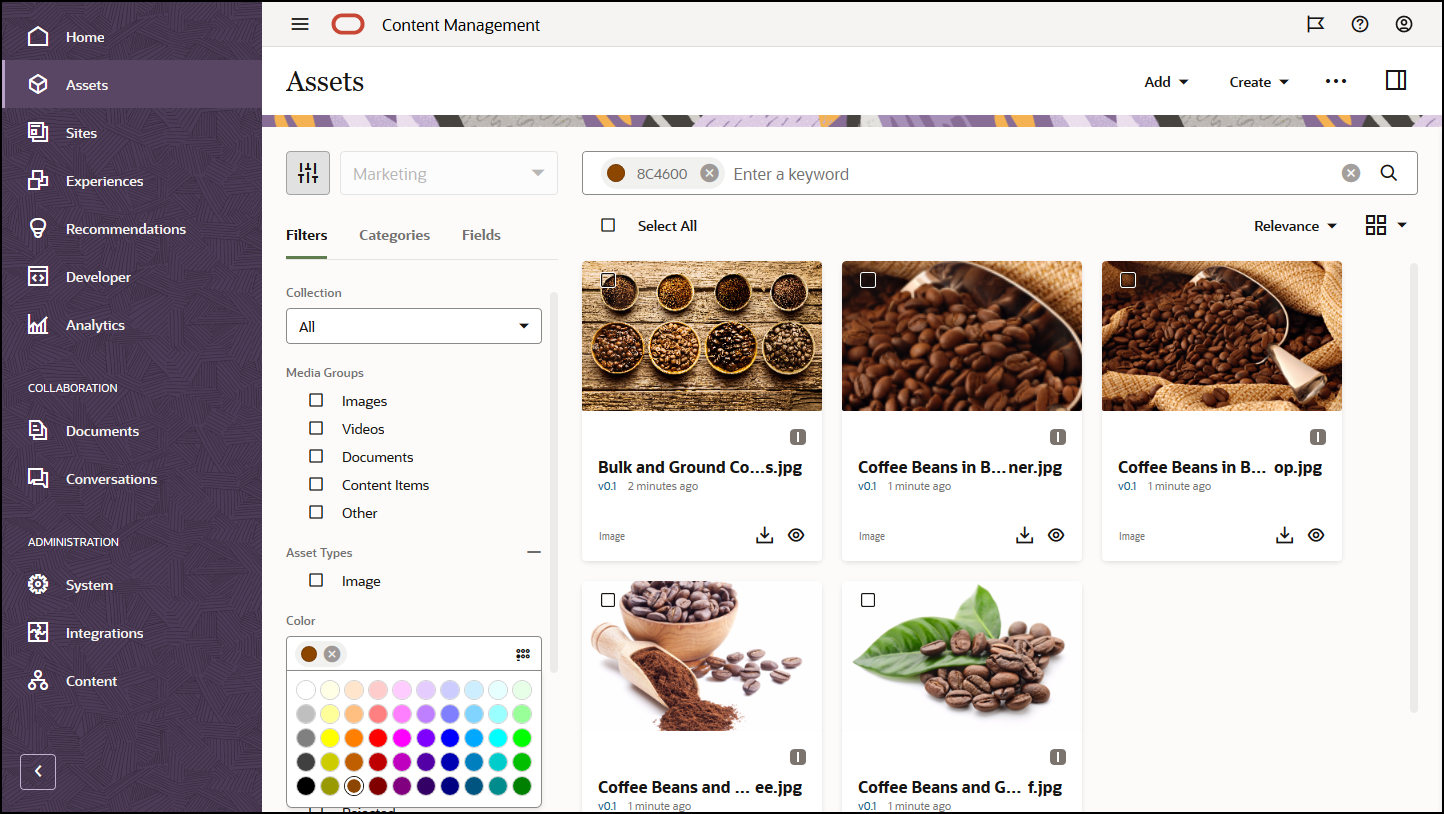
- Create empty recurring jobs. More...
- When creating an asset or site translation job, select whether to send the latest revisions of assets or the currently published revisions of assets. More...
Content Capture Improvements
- Convert image documents into PDF or text with OCR Processor Jobs. More...
- With external processor jobs, you can integrate existing or new capabilities with Content Capture such as types of document conversions to Microsoft PowerPoint or other image formats. More...
Developer Enhancements
- The Oracle Content Toolkit includes the following updates. More...
- Support for
control-recommendation. - Support for dynamic lists components in local server.
- Support for
delete-site. - Governance support for
create-site.
- Support for
21.8.1 — August 2021
Brand Portal Template
The Brand Portal Template is an easily customizable and configurable site modeled off of a fictitious company called Café Supremo. The template provides quick and intuitive access to branded assets including images, videos, PDFs, and more, hosted in an Oracle Content Management repository. Assets are organized into collections that are based on taxonomies in Oracle Content Management.
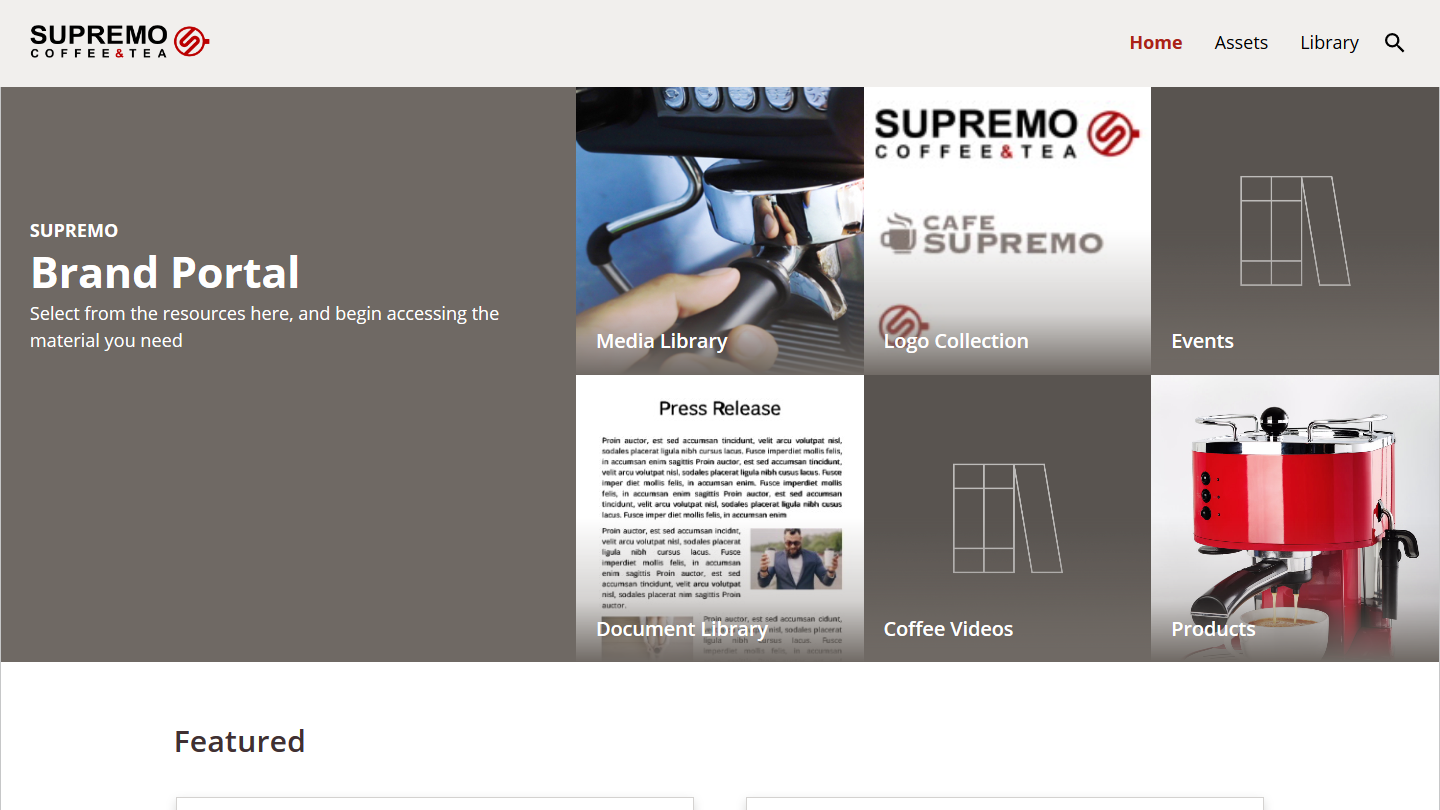
The Brand Portal Template includes the following capabilities:
- A fully customizable Home Page that provides quick access to asset collections available on the brand portal as well as a featured section that highlights recently added assets.
- An Assets page that allows users to view all the assets available on the brand portal and filter them base on their file type (image, video, document, or other).
- A Library page, similar to the File Explorer, where users can navigate to different asset collections to view available assets.
- Full search capabilities to search and find assets.
- A Review page that allows users to view assets and their metadata.
- Options for users to download assets, create shared links to assets, and request changes to assets (via email).
General Improvements
- The file feature "Reserve" has been renamed to "Lock". More...
- The page limit for previewing documents has increased from 100 pages to 300 pages. More...
- Publish site and publish recommendation are shown in a slide-out panel.
Asset Improvements
- Control how assets look on the Assets page by selecting a tile layout for each asset type. More...
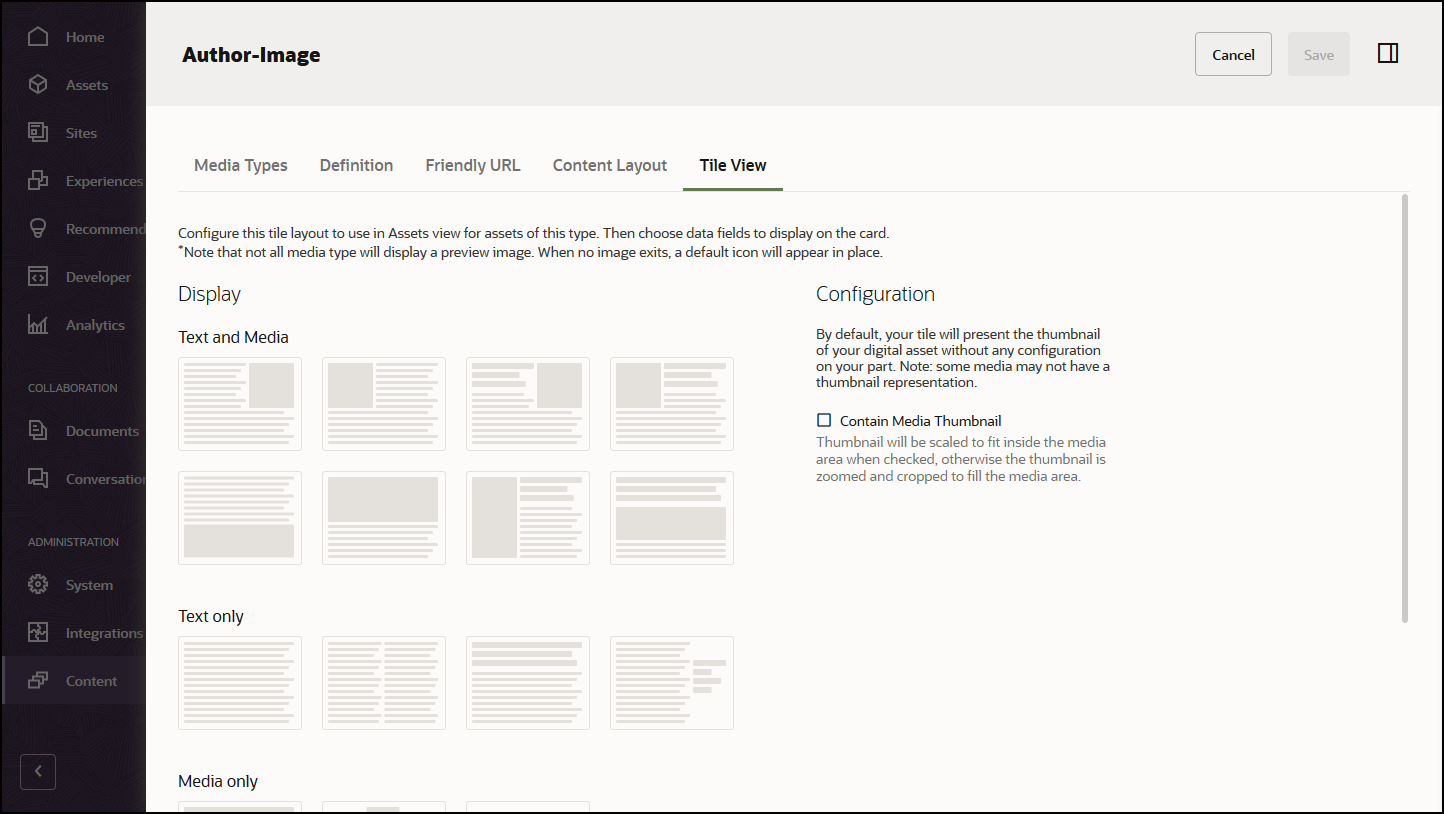
- Hide data field groups in an asset type. More...
- Submit an asset's dependencies to workflow along with the asset. More...
- In the Adobe Creative Cloud extension, search for standard property values (for example, created by or description) or custom attribute values from asset types on the new Fields tab. More...
Content Capture Improvements
- Create taxonomy lookup jobs to enable client users to select taxonomy categories or automate taxonomy searches using a Capture field value. More...
- Import content from an on-premise WebCenter Content instance to Oracle Content Management. More...
Developer Enhancements
- Share experience objects with other users. More...
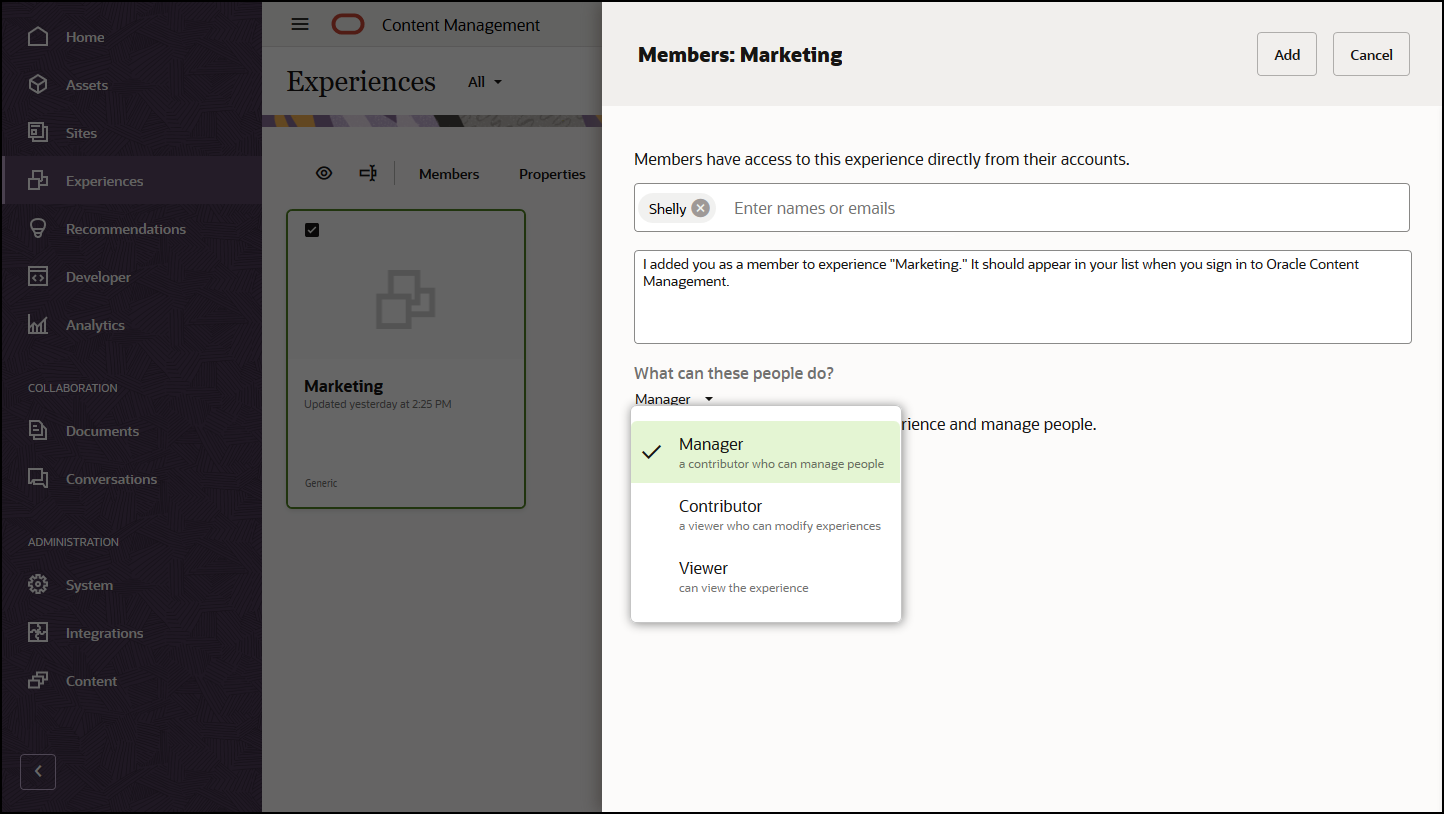
- The Dynamic List component supports compilation.
- The Oracle Content Toolkit includes the following updates. More...
- The OCE Toolkit has been renamed Oracle Content Toolkit or Content Toolkit for short.
- Add and remove languages from a repository.
- Create and control collections.
- Create a Prerender Page Refresh Webhook to notify Prerender server when an asset has been published to a site channel and a cached site Detail page needs to be updated. More...
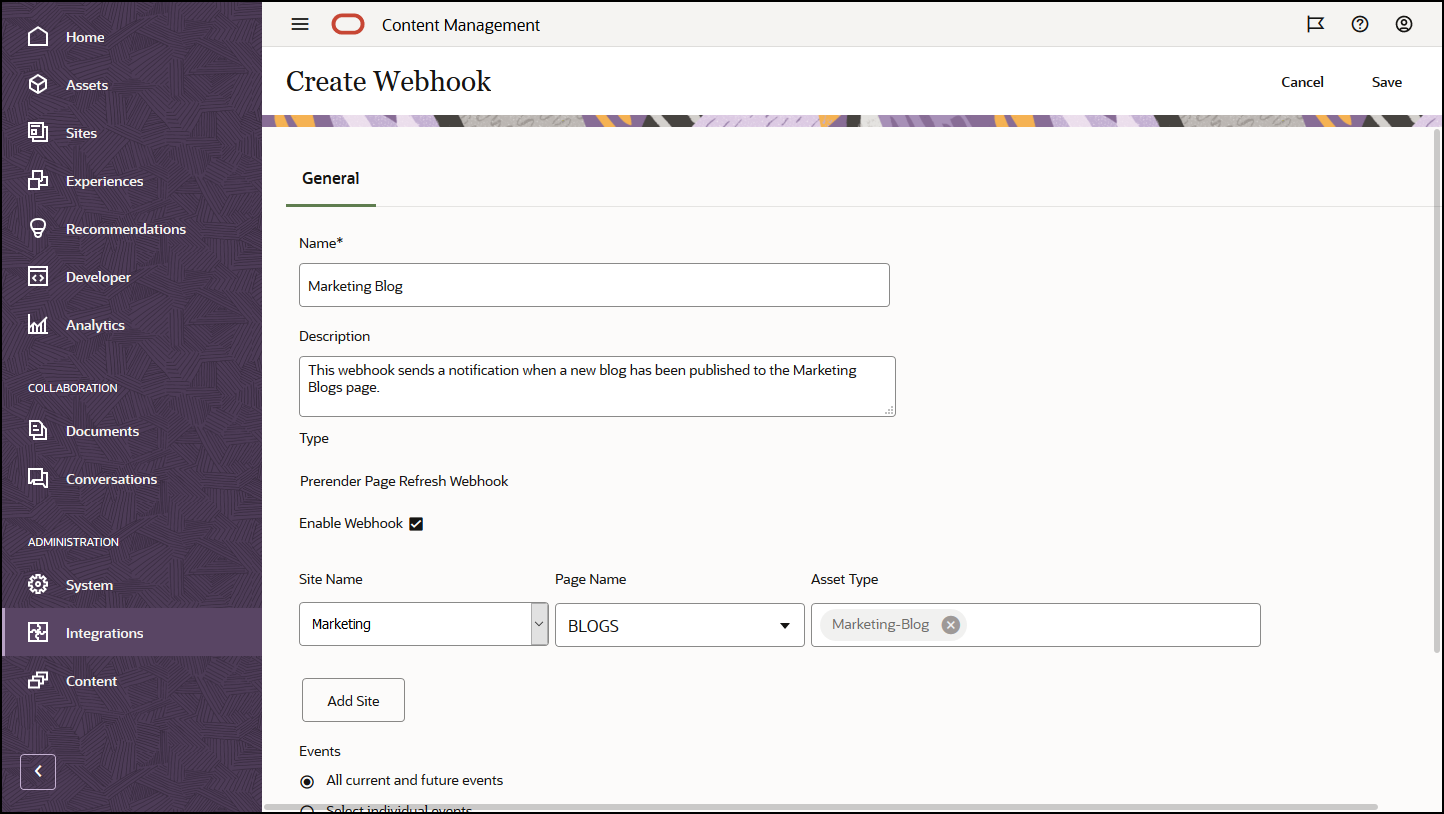
- Set a friendly management URL that users can use to access Oracle Content Management. More...
- New Asset Details Report lists all assets and their attributes. You can filter by repository, date, or asset type. More...
21.7.1 — July 2021
- Utilize granular control over editorial permissions on assets in a repository based on asset type or its taxonomy categorization. More...
- Control which users and groups have permission to view, update, create, or delete assets in repository, or categorize assets into specific taxonomy categories.
- Grant default permissions to users and groups (with Any Type and Any Category settings).
- Use explicit rules on specific asset types and taxonomy categories to limit or expand the default permissions as needed.
General Improvements
- The Documents page Favorites view and Shared with You view shows folder members, tags, and metadata in a slide-out panel. More...
Asset Improvements
- Create recurring publishing jobs. More...
- Use custom field editors and custom forms on digital asset types. More...
- Smart keywords support French and Spanish. More...
Content Capture Improvements
- Choose whether, during commit processing, assets and content items should always be created, the system should run a search first, or it should look for their references. You can also choose what the system should do when it finds multiple assets and content items if you choose to search first. More...
Developer Enhancements
- The OCE Toolkit includes the following updates. More...
- Upload HTML generated for a compiled site back to the Oracle Content Management server.
- Test calls on /system/api/v1/me or /sites/management REST API on a local OCE Toolkit server.
- The assets query in OCE Toolkit supports Scroll API to return any number of assets (no 10K limit).
- The Starter-Blog-Post-Form in StarterTemplate includes sample settings to control sidebar panels.
- Custom Content Form SDK supports hiding the sidebar panel entirely or hiding selected panels from the sidebar. More...
- View data about the most used assets in your system. More...
21.6.1 — June 2021
General Improvements
- Oracle Content and Experience has been renamed to Oracle Content Management.
- Introducing Oracle Content Management Starter Edition, a free content service tier to try out and learn the key features of Oracle Content Management. More...
Experience Orchestration
- Connect content repositories and publishing channels to headless experiences developed and managed outside of Oracle Content Management and automatically trigger deployments based on content changes or published status. More...
- Without leaving Oracle Content Management, preview, in context and with content, your headless applications. More...
- Headless experience developers can work with tools they already know and configure headless experiences to automatically drive continuous integration/continuous deployment (CI/CD) based on content operations. More...
Asset Improvements
- Convert a digital asset from an out-of-the-box digital asset type (Image, Video, Video Plus, or File) to a custom digital asset type. More...
- Added Video Plus support to custom digital asset types. More...
- View the history and details of all past asset publishing jobs on the new Publishing Event Logs page. More...
- Search for standard property values (for example, created by or description) or custom field values from asset types on the new Fields tab. More...
- Automatically unlock reserved assets after publishing. More...
- View and manage your Oracle Content Management files and folders from the Adobe Creative Cloud extension in the new Documents view. More...
Content Capture Improvements
- Convert documents to PDFs using the PDF option. More...
- Validate your procedures. More...
- When organizing documents, remove blank pages or separate documents on blank pages. More...
Developer Enhancements
- Set up a vanity URL to allow users to access an Oracle Content Management site on a specified domain rather than an Oracle Content Management instance domain. More...
- Content List and Content Placeholder components support out-of-the-box digital asset types. More...
- Add result count to your custom content layout for a Content List component. More...
- Add an asset picker to a custom component. More...
- Various enhancements to the embedded user interface functionality: now supports asset action events, asset items published view, asset items unpublished view, and results displayed event so assets can be selected on load. More...
- Content connectors support custom digital asset types. More...
- Search API supports queries on custom fields across asset types and added Scroll API to support queries that match large number of items (unlimited). More...
- Set the token expiration for Video Plus assets. More...
- Set the default share link type (members only or public). More...
- View data on documents with no activity and document updates vs. newly added documents. More...
- View the users with the most activity and the users that use that most storage. More...
21.5.1 — May 2021
General Improvements
- In list views, the actions bar now shows icons rather than text for most actions.

Asset Improvements
- Category filters show a dynamic count of the number of assets assigned to that category and any children of the category. More...
- When uploading digital assets, assign the same attribute value to multiple assets at the same time. The assets must be of the same asset type. More...
- Business repositories now support content workflows. More...
Analytics Updates
- See orphaned assets—assets that haven't been published for a selected period—to help you discover assets that might be able to be deleted to reduce the number of assets you're billed for. More...
- Filter on file or folder name and GUID in the Documents Usage Log. More...
Developer Enhancements
- Content connector for Contentful. More...
- The OCE Toolkit now supports export/import of categorized content for customers with 100+ taxonomies. More...
- GraphQL support for all published content and all asset types. Developers can inspect the schema, build queries, and invoke them from clients alongside other delivery APIs. More...
- New documentation on compiling layouts as HTML. More...
- New REST API for Self-Management, which provides the ability to view the authenticated user details. More...
21.2.2 — April 2021
Content Capture
- New capture capabilities make it easier to ingest content such as hard copy or electronic documents. More...
- Capture content from an array of different content sources, such as email, a scanner, or a network file share. More...
- Convert scanned content using optical character recognition into fully indexed, searchable PDFs. More...
- New business repositories scale to support storing millions of documents. More...
Workflow Updates
- Set default or required workflows for your asset types. More...
- Trigger workflows automatically when assets are added or created. More...
- Scheduled publishing jobs support targeted channels. More...
- Search for past and future scheduled publishing jobs. More...
General Improvements
- View analytics on Video Plus assets. More...
- The Documents page shows folder members, tags, and metadata in a slide-out panel. More...
- Desktop client creation and last modified dates match the web client. Last modified date is updated only when the file or attributes are modified. More...
Developer Updates
- OCE Toolkit supports exporting and migrating more than 10,000 assets per batch. More...
- Precompile HTML for content items and custom digital assets. More...
- Repository managers can precompile HTML for asset types that support precompiling. More...
- Content List and Content Item components in sites support rendering custom digital assets. More...
- In the June 2021 (21.3.1) release Oracle Content Management will upgrade Knockout library from v.3.4.2 to v.3.5.1 which may impact your custom components. More...
21.2.1 — March 2021
Scheduled Publishing
- Schedule assets to be published at a particular date and time. Asset versions are reserved for publishing, allowing work on new versions. More...
- View a calendar of publishing jobs to see the status of past jobs, or to edit or cancel future jobs. More...
- Edit a pending job to allow other users to manage the job, add additional assets, or change the schedule. More...
- Copy a completed job to publish the assets again in the future. More...
General Updates
- Digital asset types support friendly URLs. More...
- Digital asset types support content layouts. Preview digital assets in the associated layouts. More...
- Download multiple files and folders at the same time. More...
- The desktop client supports moving files no longer being synced to an Unsynced Content folder for easy recovery instead of the system recycle bin (Windows) or trash (MacOS). More...
- In the embedded user interface, delete published assets if you have permission to unpublish them. More...
- Information about REST API categories has been updated. More...
- More Headless CMS samples have been added to GitHub. More...
21.1.3 — February 2021
Repository Updates
- Filter assets that aren’t targeted, categorized, or in a collection. More...
- Enable a site to use assets from multiple repositories. More...
- Define whether an asset reference is required or optional for publishing. More...
- Limit media reference fields to specific digital asset types or media groups. More...
- Convert legacy repositories or individual digital assets to support new custom digital asset types. More...
Developer Enhancements
- Content connector for WordPress. More...
- Content connector for Drupal. More...
- Headless Blog samples in Oracle JET, React, and JavaScript. More...
- Headless Gallery sample in React. More...
- Headless Minimal Site sample in React. More...
- Custom controller file samples. More...
Other Updates
- One-step content approval and publish workflow example. More...
- Content metric showing assets that have been reviewed but not published. More...
- The samples have been moved from Developing with Oracle Content Management As a Headless CMS to the Samples page in the Oracle Help Center. More...
21.1.2 — January 2021
General Updates
- Smart content generates real-time category suggestions so content authors can classify content items during creation. More...
- Edit referenced assets directly from the parent asset. More...
- Unpublish translated assets from the Languages panel. More...
Developer Enhancements
- OCE Toolkit supports asset types. More...
- Create Mustache components and use them in sites. More...
- Incoming webhooks support the Lingotek translation connector. More...
- Embed API supports hiding the status on a card and cross-component navigation. More...
- Assets Search API supports dynamic results count on categories. More...
- New content connector for Drupal. More...
- New content connector for WordPress. More...
Administration Enhancements
- Keep your content relevant for your audiences by monitoring analytics on the age of published assets. More...
- Oracle Content Management now collects anonymous product usage data to help us improve the product. More...
- You can now update the instance type (primary or non-primary) on an Oracle Content Management instance after creation. More...
21.1.1 — January 2021
Custom Digital Assets
- Create digital asset types, defining attributes to store custom metadata, and specifying the supported media types to control what files can be added to a repository. More...
- Out-of-the-box digital asset types for images, videos, Video Plus assets, and files. More...
- Search for assets based on attribute values or filter them by asset type or media group. More...
General Updates
- Lock assets to prevent unwanted updates, for example, while waiting for approval or translation, then unlock them when you’re done. More...
- Download multiple digital assets in a zip file. More...
Developer Enhancements
- Enhance your translation connector with a custom user interface for translation jobs to collect additional information before submitting a job to your translation vendor. More...
- Create custom forms for editing content items. Leverage the supplied reference implementation to create a custom solution that fits the requirements of your organization. More...
Content Delivery Network Support
- Default Content Delivery Network (CDN) support. OCE sites and assets are now delivered using a CDN for improved performance and security. More...
- Updated cache headers for assets significantly improve response and download times.
- Edge security ensures content delivered by OCE isn’t impacted by various types of nefarious traffic.
Documentation Accessibility
For information about Oracle's commitment to accessibility, visit the Oracle Accessibility Program website at http://www.oracle.com/pls/topic/lookup?ctx=acc&id=docacc.
Access to Oracle Support
Oracle customers that have purchased support have access to electronic support through My Oracle Support. For information, visit http://www.oracle.com/pls/topic/lookup?ctx=acc&id=info or visit http://www.oracle.com/pls/topic/lookup?ctx=acc&id=trs if you are hearing impaired.
Oracle Cloud What’s New for Oracle Content Management
F77347-20
January 2024
Copyright © 2017, 2024, Oracle and/or its affiliates.
Primary Author: Kalpana N
Contributors: Sarah Bernau, Jean Wilson
